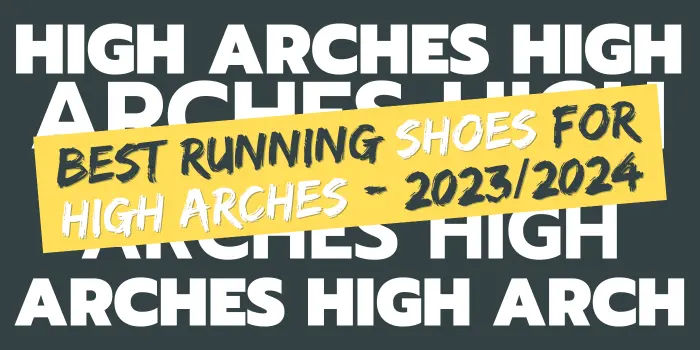
As we wave goodbye to 2023 and step into the fresh strides of 2024, it’s time for me to give you some of the best running shoes for high arches.
I understand the struggle of finding the perfect running shoes for high arches—it’s no easy feat. The good news is, I’ve got your back with a thorough review of some fantastic options to make your search a whole lot easier.
So, buckle up, or in this case, lace up, as we explore the finest running footwear for high arches in 2023-2024.
Also, if it’s a hassle for you to find some of the best sandals for your high arches, check out these sandals that might just be your next best friend.
Best Running Shoes for High Arches
Before we kick things off, I’m Eric Barber, the runner behind steadyfoot.com. I want to make a quick disclosure that all the shoes mentioned in my reviews have been personally purchased. I believe in providing unbiased and authentic insights based on my own experiences. Your trust is essential and thanks for being part of the Steady Foot community!
Hoka Clifton 9
Cushioned ride for long-distance runs
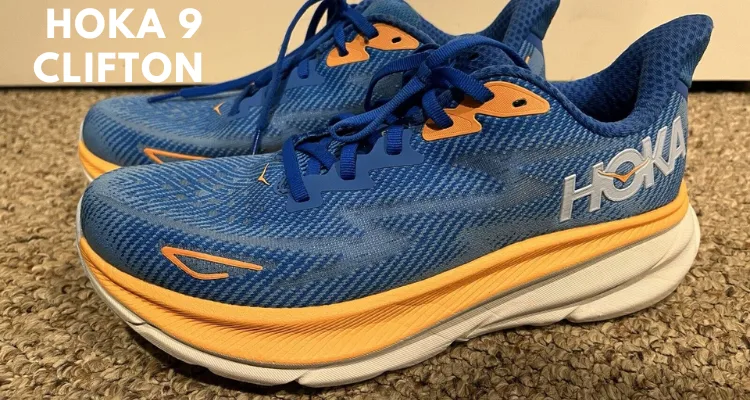
Neutral 〉 W: 7.7 oz 〉 M: 9.0 oz 〉 Drop: 5 mm 〉 Heel: 40 mm 〉 Forefoot: 35 mm
The Clifton 9 is arguably Hoka’s most popular running shoe. It just sits right in that sweet spot of what the majority of runners are looking for in everyday running shoes.
If you have high arches and you’re looking for something comfortable, something light, and a shoe that you don’t have to think too much about for it to do its job, give the Hoka Clifton 9 or the Clifton 8 a shot.
The arch support is on point and you’ll feel the pressure taken off your feet. The upper doesn’t squeeze your feet too much either, giving you that sweet spot between support and comfort. And honestly, it’s like walking on clouds with that cushy midsole.
So, if you have high arches and you’re looking for a neutral recovery shoe or an easy day shoe, or if you just want one pair of shoes and sometimes you’ll pick up a little bit, the Clifton 9 is going to suit you well.
The Clifton is definitely the type of shoe that you put on when you want to go and log those bread-and-butter daily miles.
But also, if you do a job where you’re on your feet all day, I think the Clifton 9 is definitely one to consider simply because it is outrageously comfortable when you’re just walking around.
Related:
New Balance 1080v13
Soft ride for long-distance runs
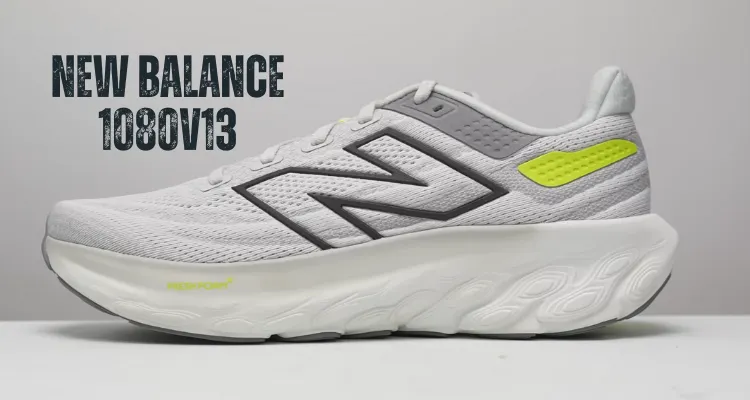
Neutral 〉 W: 8.1 oz 〉 M: 9.3 oz 〉 Drop: 6 mm 〉 Heel: 37 mm 〉 Forefoot: 31 mm
The Fresh Foam X 1080v13 is New Balance’s premier training shoe and an excellent choice for high arches. It uses a plush Fresh Foam X midsole and provides remarkable cushioning and support.
Depending on where your fitness is at and how you like to run for everyday miles, the 1080v13 could be a daily trainer for you, but for faster runners, this is likely going to be a recovery-day shoe and it’s most definitely a comfort-oriented shoe.
This is a neutral running shoe so it doesn’t have any elements added to prevent overpronation, but it is a shoe with some decent elements of inherent stability.
Overall, the 1080v13 is a great shoe if you want a nice relaxed running shoe that can handle daily slow miles as well as recovery running efforts. Keep in mind that it’s not designed to be an aggressive or fast-paced shoe.
To make sure the New Balance’s numerical system won’t confuse you, here’s our comparison of the New Balance 1080 vs. New Balance 880.
1080v13 vs. Nimbus 25
Compared to the Nimbus 25, the 1080v13 is a little bit more responsive and slightly lighter. It’s just easier to navigate through runs with the 1080v13, which makes it a great all-around do-it-all shoe.
The 1080v13 is more versatile because it doesn’t have as much of a soft sink-in feeling as the Nimbus. I also think the Fresh Foam X is going to hold up a little bit better in the long term.
I also think the 1080 is going to be a little bit better for standing on your feet all day just because it’s a flatter platform. You’re not going to get that sink-in feeling or that upward curve that wants you to keep moving.
Of course, if you just want max stack ultimate comfort to be super wrapped up in a marshmallowy feel, then the Nimbus is a shoe for you.
Related:
1080v13 vs. Saucony Triumph 21
If we’re talking about the New Balance 1080v13 and the Saucony Triumph, it’s a tough call for me. I find the 1080 a tad softer and more relaxed. On the flip side, the Triumph brings more bounce and energy, especially when you want to pick up the pace—it’s a bit more responsive than the 1080v13.
So, if you’re looking for a shoe for your long runs, mixing in some marathon pace and occasional pickups, I think the Triumph takes the cake there. It just handles those scenarios well.
However, if you’re after an easy, relaxed shoe for everyday runs, or slow recovery runs, the 1080v13 gets my nod. It’s all about what you want from your miles.
1080v13 vs. Saucony Endorphin Shift 3
When comparing the Saucony Endorphin Shift 3 to the New Balance 1080v13, the Shift 3 is a firmer and much more rockered option.
The Shift 3 is a close-to-40mm heel stack and offers stability from a plastic clip at the back. The PWRRUN foam it employs contributes to a firmer feel compared to the 1080.
Related:
Saucony Endorphin Shift 3
Great heel-to-toe rocker roll
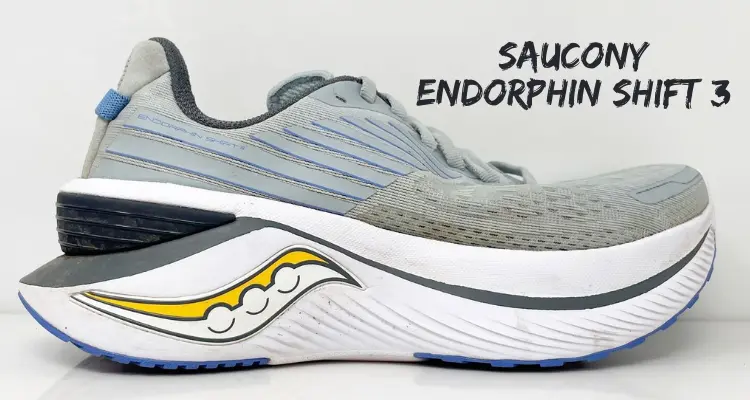
Neutral 〉 W: 8.2 oz 〉 M: 9.3 oz 〉 Drop: 4 mm 〉 Heel: 41 mm 〉 Forefoot: 37 mm
The Saucony Endorphin Shift 3 is well-suited for high arches and provides the necessary support and comfort for runners with elevated arch profiles.
The Shift 3 is a pretty cushy pretty stable non-plated brother of the Endorphin Pro and the Endorphin Speed. This is going to be your bread-and-butter daily trainer that you are going to take for your easy runs.
Of course, it can pick up the pace a little bit, but Saucony has a lot of better options for that.
I have run in heavier shoes that sometimes feel heavy, but for me at least, the Endorphin Shift 3 does not feel heavy on my foot. This is going to take your foot and wrap it in a cocoon of cushion and it’s going to make you feel good for your entire run.
Again, the Endorphin Shift 3 is the shoe that you look forward to just going out and enjoying your run; not the runs that you have to put in efforts, but the ones where we go out and log the miles.
Last but not least, the Shift 3 is a great shoe for Morton’s neuroma and a reliable option for Metatarsalgia, aka, ball-of-foot pain.
Related:
Asics Gel Nimbus 26
Soft ride for daily training
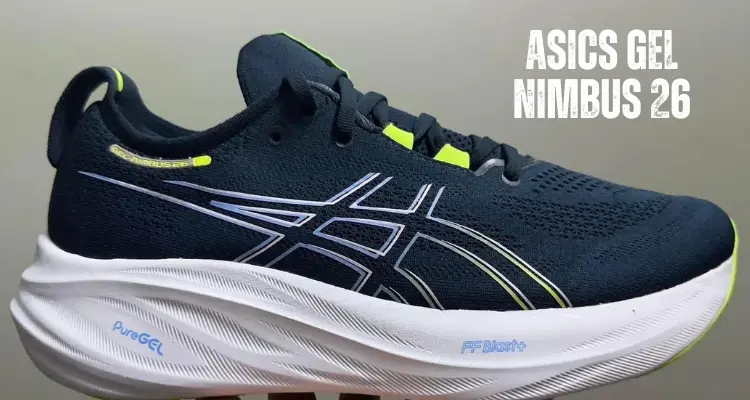
Neutral 〉 W: 9.2 oz 〉 M: 10.7 oz 〉 Drop: 8 mm 〉 Heel: 41.5 mm 〉 Forefoot: 33.5 mm
The Nimbus 26 is another solid premium plush daily trainer which happens to be a great choice for runners with high arches.
It is ridiculously comfy and it’s going to give your feet a warm hug. The arch support is fantastic, which is good, especially for supinators/underpronators.
Seriously, I feel like I’m walking on clouds with these. And the best part? No need for orthotics – the arch support is on point.
The Nimbus 26 is a pretty soft shoe for a daily trainer, especially if you like running a little longer and you want to be pampered. If you’re training for a marathon and you need to get these long easy runs in, the Nimbus 26 is actually going to feel really good on your feet.
The Nimbus is one of those shoes that adapt perfectly to a second life. So, when you’re done putting in your run miles into the Nimbus 26, this is a shoe that transitions well to doing everything else like a lifestyle shoe and that’s mainly because it is just a crazy comfortable shoe.
Make sure you check our comparison of the Asics Gel Nimbus and Asics Gel Cumulus. Last but not least, the Nimbus is of these great shoes with a wide toe box and narrow heel.
Saucony Triumph 21 RFG
Cushioned ride for long-distance runs
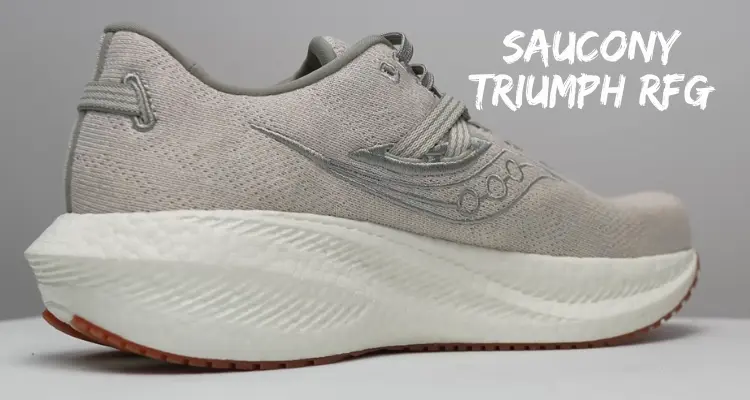
Neutral 〉 W: 9.7 oz 〉 M: 10.4 oz 〉 Drop: 10 mm 〉 Heel: 39 mm 〉 Forefoot: 29 mm
First off, RFG stands for Run For Good.
The problem with eco-friendly midsoles is that they’re generally not that good. However, I’m very happy to report that I really enjoyed this PWWRUN+ Bio midsole material that I don’t mind running in.
I do think it is a little bit firmer than the PWWRUN+ that we normally see in the Triumph series, but it still felt like a foam that had plenty of impact absorption that also bounced off the ground really well, so it made for a very pleasant running experience.
So, the Saucony Triumph RFG is a revelation in running shoe comfort and support. If you often struggle to find the right fit, the Triumph provides the necessary support in all the right spots for high arches.
Related:
Nike Structure 25
Daily training with a supportive ride
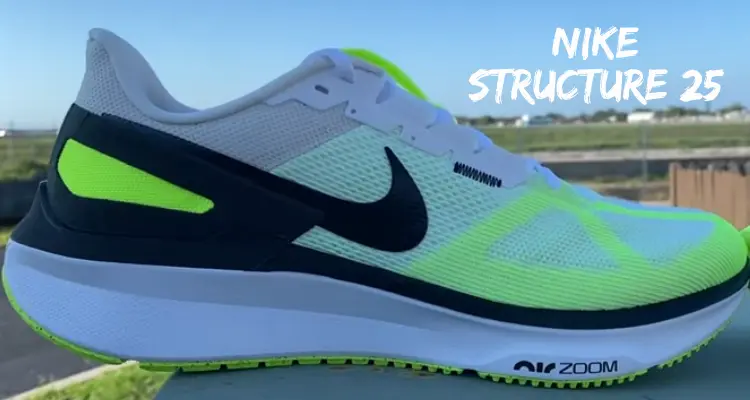
Stability 〉 W: 9.0 oz 〉 M: 10.8 oz 〉 Drop: 10 mm 〉 Heel: 37 mm 〉 Forefoot: 27 mm
The Nike Air Zoom Structure 25 is a mid-range daily trainer designed to be Nike’s most supportive running shoe for runners who need stability.
Nike often uses advanced arch support technologies, and their shoes have exceptional cushioning and stability. The Structure 25 helps distribute pressure evenly across your foot, reduces discomfort, and enhances overall performance, which is particularly beneficial for runners with high arches.
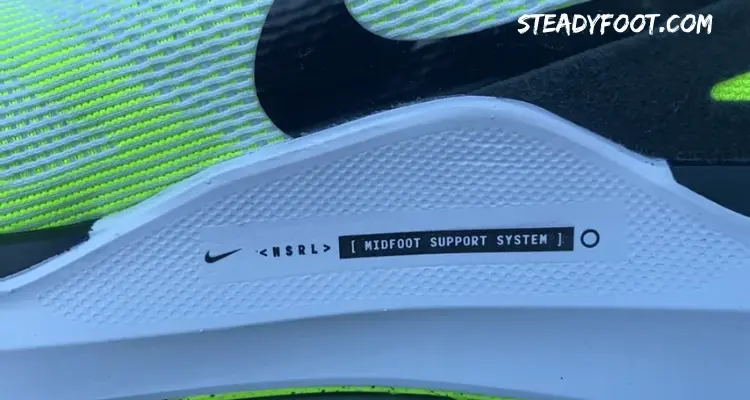
Overall, if you’re an overpronator and/or have high arches, the Structure’s very prominent arch area is super helpful. However, if you’re not a fan of prominent archers in running shoes, go for the previous Structure 24.
And, if you prefer the stability to come from other less intrusive features like a wider base or GuideRails, then shoes like the Adrenaline GTS are good options.
Related:
Nike Pegasus 40
Supportive ride for faster paces
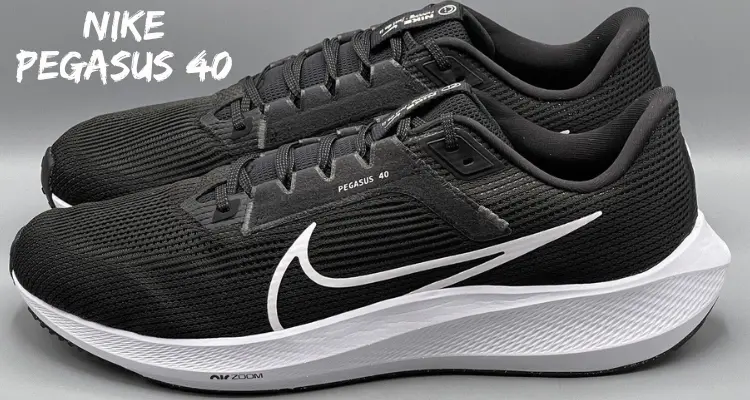
Neutral 〉 W: 7.7 oz 〉 M: 9.4 oz 〉 Drop: 10 mm 〉 Heel: 33 mm 〉 Forefoot: 23 mm
The Nike Pegasus is another excellent option for runners with high arches. It features a responsive and supportive midsole and an upper that offers a secure fit, which makes it a standout choice for those prioritizing stability and comfort in their runs.
I feel like at strides and at faster paces, the Pegasus 40 does really nice. I’m not sure I’d want to do a full-blown workout in these, but if you’ve got a regular day or an easy run and maybe you have some hill sprints or maybe you have a couple of strides that you have to do towards the end of the run, I feel like the Pegasus 40 is going to be able to live up to that task.
The Pegasus continues to be a great daily trainer for those runners who are new to running or coming back to running after a long hiatus or for those younger runners who are very experienced like high school and middle school runners in their track or cross-country seasons.
If you want something even softer, the Vomero is the way to go. Here’s our comparison of the Nike Pegasus vs. Nike Vomero.
Related:
Asics Gel Cumulus 25
Versatile daily trainer
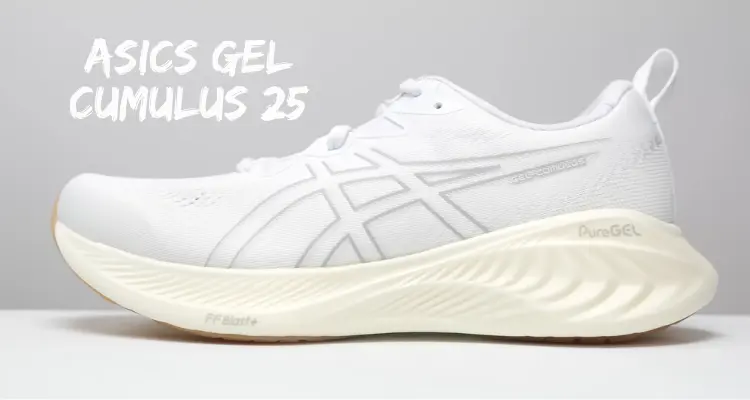
Neutral 〉 W: 8.3 oz 〉 M: 9.0 oz 〉 Drop: 8 mm 〉 Heel: 39 mm 〉 Forefoot: 31 mm
The Asics Gel Cumulus 25 is well-suited for runners with high arches. The midsole contributes to a smooth and supportive ride, which makes it a reliable choice for runners looking for comfort and a hint of stability through their gait cycle.
Asics has a lot of different models and it can be confusing. The Cumulus is their flagship neutral daily trainer, which essentially means it does a little bit of everything.
It’s meant to be a versatile training option. And then the Nimbus is basically the max cushion training shoe within the Asics lineup. It’s basically the thicker version of the Cumulus.
If you really want all the plushness in the world at least in terms of daily trainers, check out the Nimbus or the Superblast, but I think the Cumulus 25 isn’t too far behind.
Related:
On Cloudstratus 3
High-milage trainer
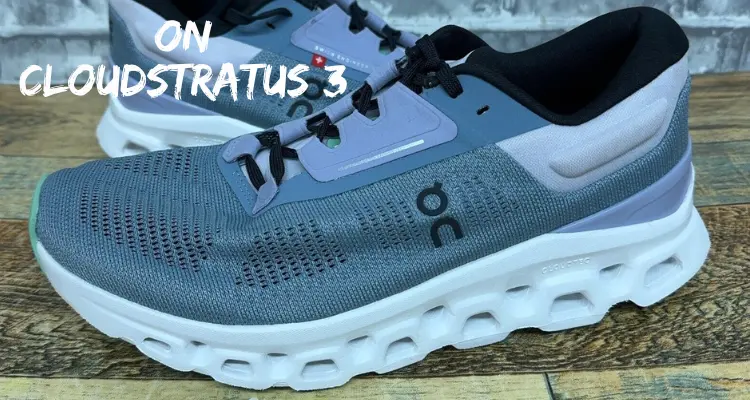
Neutral 〉 W: 9 oz 〉 M: 10.3 oz 〉 Drop: 6 mm 〉 Heel: 37 mm 〉 Forefoot: 31 mm
The Cloudstratus is another great option for high arches. It offers dual-layer CloudTec cushioning that delivers remarkable impact absorption and support and ensures a superior and comfortable running experience.
This is a max cushioned shoe from the company known for its clouds, but ON has taken its cloud technology and literally doubled down.
I like the Cloudstratus as an easy-run shoe that I want for my regular runs but not necessarily for my recovery runs and not necessarily for my workouts.
So, an ideal day for me and the Cloudstratus would be if I’m just going out for a medium-length run or even a long run that’s just going to be at a very easy aerobic pace – that’s where I feel like the Cloudstratus works really well for me.
Ultimately, I think that the person that I would recommend the Cloudstratus for is someone who is a higher-mileage runner who’s training for a marathon or maybe has trained for many marathons before and is doing high-mileage weeks and just wants something that’s going to be really comfortable to absorb a lot of the regular runs that you’re running multiple times per week.
Related:
Adidas Solar Glide 6
Stable ride for daily training

The Adidas Solar Glide 6 is a workhorse neutral daily trainer designed to handle a ton of miles and last quite a while. It features a responsive midsole that offers excellent energy return and cushioning and provides support for runners with high arches.
The Solar Glide works better for those slower to medium-paced efforts. It’s not the fastest shoe out there mainly because it does weigh quite a bit, it’s a little bit bulky, and it does have a ton of ground contact.
The other interesting thing about this shoe is its LEP system which stands for Linear Energy Push. It’s basically a plastic torsion bar that runs through the middle of the shoe to keep the shoe from twisting and acts as a torsion system.
Related:
Best Running Shoes for High Arches – Full Reviews
Hoka Clifton 9 (Full Review)
I think the Clifton 9 really fits the bill with its improvements over the Clifton 8.
Midsole / Outsole
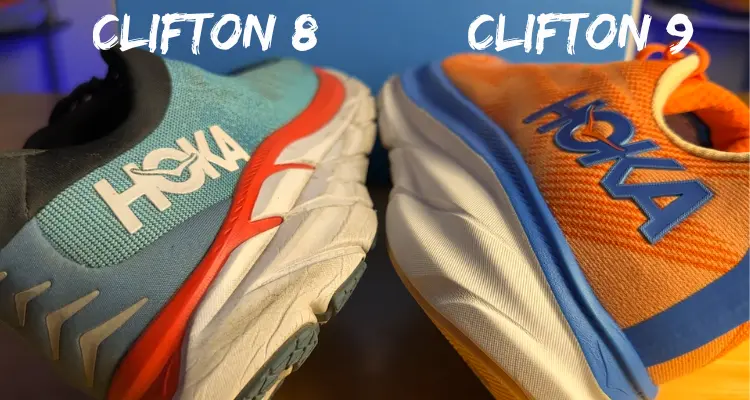
Hoka is using their compression-molded EVA in the Clifton 9, but what sets it apart is the tweaked formulation of this foam. If you’re thinking it’s just another shoe with EVA, Hoka has actually crafted a foam that feels notably nice, soft, and fairly responsive.
Although the Clifton is a neutral shoe, it surprisingly offers stability. If you’re in need of additional stability, this might not be the shoe for you. However, for those seeking a stable ride in a neutral shoe, the Clifton 9 is a fitting choice.
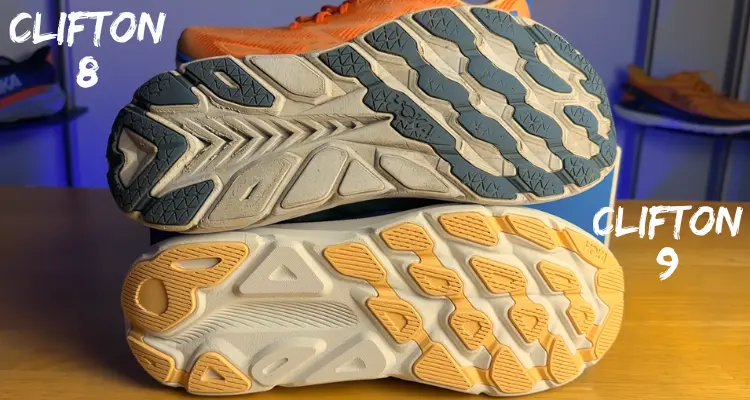
With a considerable amount of sole flare on both sides, the shoe establishes a stable platform for your runs. On the outsole, Hoka uses a combination of Durabrasion rubber and exposed EVA to make sure you get the grip needed.
Related:
Upper
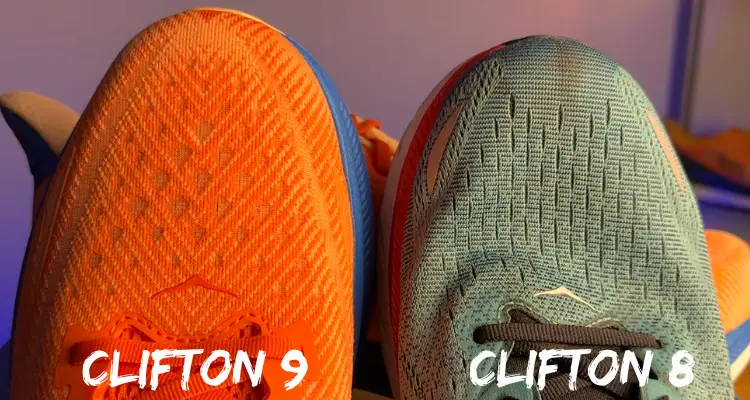
The upper of the Clifton 9 is made from a breathable engineered mesh that has strategically placed holes for ventilation. I’ve personally tested these shoes on warmer days, and I found my feet to be surprisingly comfortable.
There is an underlay right around the toe box to keep that toe box nice and high. This design not only ensures a comfortable fit but also keeps the upper slightly elevated from your foot, which contributes to a refreshing airflow sensation and a sense of spaciousness.
As for the tongue, it’s partially gusseted, specifically on the medial side. This design choice prevents the tongue from migrating and sliding around, thanks to a thin piece of mesh connecting it to the base of the upper. It’s these thoughtful details that add to the overall positive experience of wearing the Clifton 9.
The Clifton 9’s heel collar is nice and padded and has a very prominent Achilles flare/pull tab area. The heel design is particularly good for individuals dealing with Achilles issues, as it seems to contribute to minimizing any potential aggravation of the Achilles tendon.
The sturdy heel counter adds a layer of rigidity and stability to the rear, which helps prevent heel slipping or excess movement. It aligns perfectly with what we seek in a reliable daily trainer.
Related:
Weight and Fit
Hoka managed to reduce the weight while increasing the stack height by three millimeters just giving us that extra cushion without changing the 5mm drop.
As far as the weight, for a daily trainer, the Clifton 9 is a surprisingly light shoe, coming in at 8.7 oz. or 248 grams for US size 9.
In terms of fit, the Clifton 9 does fit true to size and is available in wide sizes. However, I personally find it to have a slightly wider toe box, especially when compared to the Hoka Bondi.
So, the Clifton 9 offers a bit of roominess through the toe box and delivers exactly what a daily trainer should feel like—a treat for your feet.
Related:
What it feels like to run in the Clifton 9
I’ve got to tell you that the Clifton 9 has been a savior for my body, especially during times when my feet felt worn out from my weekly training.
It simply feels good, soft, and cushioned, and it provides everything I crave in an easy-running recovery-day shoe. Surprisingly, when I need to pick up the pace, the Clifton delivers.
In my opinion, the Clifton caters to the widest audience among the shoes I’ve reviewed. The generous amount of rubber on the outsole, coupled with ample cushioning, comfort, and an enjoyable ride, makes me believe that many people can get a lot of benefits from the Clifton 9.
Again, the Clifton 9 stands out as a remarkably solid daily trainer. However, if you’re looking for a Hoka shoe for your daily training and want something with a bit more speed, I think the Hoka Mach 5 is a little better suited to picking up the pace.
On the flip side, the Clifton, with its enhanced durability, performs better at those slower paces where we log most of our miles. When you consider the Clifton 9 for its intended purpose, it’s challenging to find any faults.
Related:
Shoes you can pair with the Clifton 9
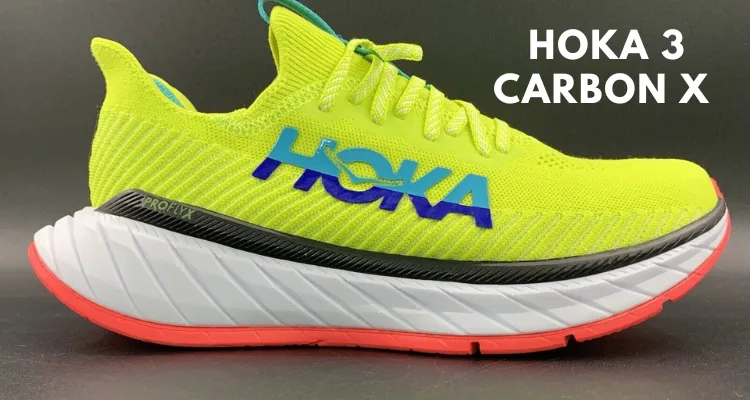
If you’re looking for a racer, I think the Carbon X with its Peba foam would make an excellent race shoe, complementing the Clifton 9 as your reliable daily trainer.
I feel like the Carbon X is a very speedy shoe, one that genuinely enjoys picking up the pace.
If you do have more workout needs than you have recovery shoe needs, the Hoka Mach 5 might be one to consider.

The Mach 5 uses a ProFly dual midsole foam where you’ve got that squishier layer up top and then that rubberized EVA layer on the bottom.
| Where to buy (not affiliate) | ||
|---|---|---|
| Hoka | Holabird Sports | |
Related:
Asics Gel Nimbus 26 (Full Review)
The Nimbus 26 is slightly heavier than the Nimbus 25, but we also have half a millimeter more stack height in the 26 over the 25.
I think you can use the Nimbus 26 for your easy and recovery day and then use the Asics Superblast, which is a non-carbon-plated shoe, for your workouts.
Midsole
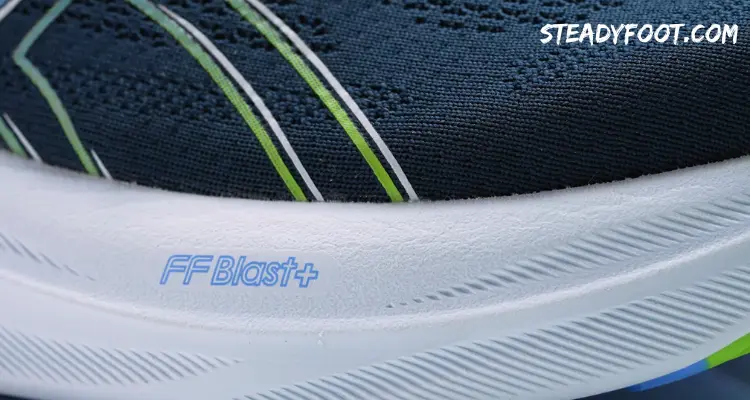
Asics is using their FlyteFoam Blast+ Eco foam (FFBlast+ Eco) in the Nimbus 26, a super plush foam that’s also eco-friendly. The shoe is made with up to 24% bio-based materials, which is a nice touch from Asics in contributing to environmental efforts.

In the heel, there’s Pure Gel, which Asics claims to be lighter and softer than conventional gel. While I may not know exactly what conventional gel is, I’m certainly not eager to try it now that I’ve experienced the softer and lighter Pure Gel.
Often, eco foams tend to make the shoes firmer, and there’s a hint of that in the Nimbus 26 compared to, say, the Novablast 3.
However, I find the FFBlast+ Eco to be one of the more successful eco-based midsoles I’ve come across. It’s truly exciting because I don’t even perceive it as an eco product; it’s simply a product that I genuinely enjoy. It offers remarkable cushioning and comfort while still retaining a bit of spring in its step.
Related:
Outsole
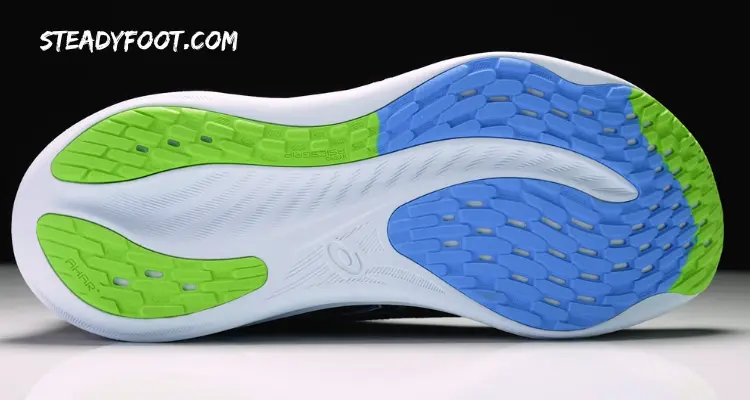
Asics has implemented some changes in the outsole, introducing Hybrid Asics Grip and AHAR+. AHAR+ adds extra resilience, endures more punishment, and extends the lifespan of the Nimbus. On the other hand, Hybrid Asics Grip is used to reduce weight while delivering excellent traction in various conditions.
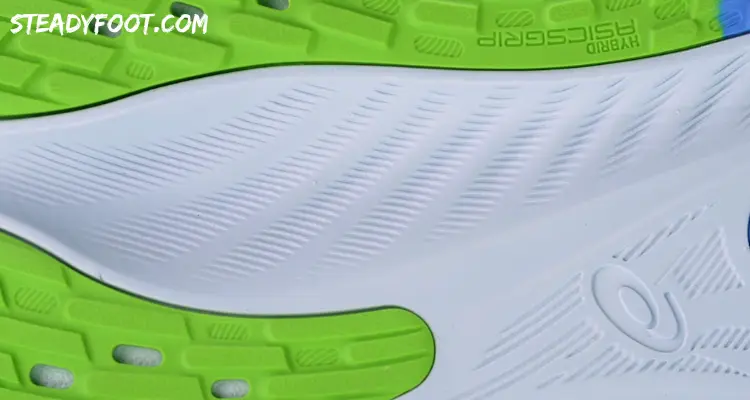
Interestingly, I had the chance to test the Nimbus 26 on a wet day, and to my surprise, the shoe clung to the road like a champ, which shows how effective this Hybrid Asics Grip is in providing reliable grip even in wet conditions.
Upper
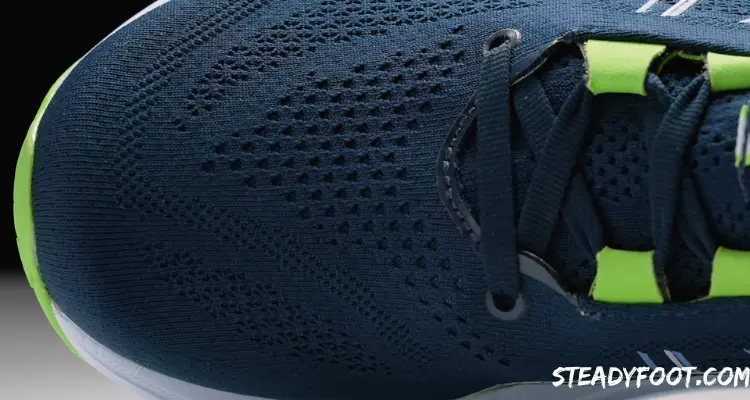
The upper of the Nimbus 26 is a very soft engineered knit, which is what we’re looking at when we want to be comfortable and go out for a run.
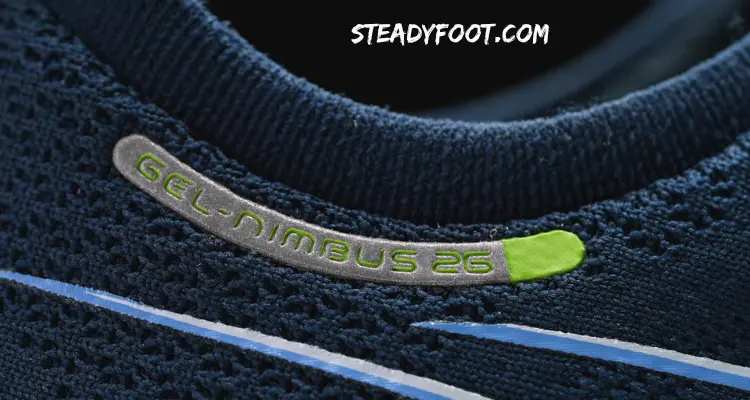
Upon slipping your foot into the Nimbus 26, it immediately envelops your foot and the upper sits very nicely against it, providing a pleasant fit.
The knit tongue adds to the overall comfort and offers a stretchy feel. With gussets on both sides, it contributes to a secure midfoot lockdown.
However, I did observe that the tongue felt quite long and came up a bit higher than what I’m accustomed to in some other shoes although I didn’t experience any issues stemming from it.
The Nimbus 26 has a lovely heel collar that’s thin at the top and transitions into a substantial plush bolster on the inside. This padding extends around the entire heel and contributes to a wonderfully comfortable step-in feel.
The padding enveloping the heel collar plays a significant role in locking in your heel securely. Paired with a rigid heel counter, a feature expected in a plush daily trainer, I experienced no issues with heel slips.
Additionally, the oversized knit heel pull tab not only adds a stylish touch but also proves to be practical in use.
Related:
Breathability
The holes on the toe box give the Nimbus 26 a look that suggests excellent breathability. However, in my experience, that wasn’t entirely the case. I noticed that the Nimbus 26 tended to run quite warm, particularly in warmer conditions.
But of course, if you live in a colder climate, this could be an advantage. The shoe might keep your feet comfortably warm during easy runs on those chilly days.
Sustainability
Asics maintains their commitment to environmental responsibility with the Nimbus 26, boasting a carbon footprint 25% lower than the industry standard.
The use of FFBlast+ Eco midsole foam in this shoe is a step towards being gentler on the environment compared to the traditional version.
What it feels like to run in the Nimbus 26
I’ve integrated the Nimbus 26 into my routine as one of my go-to shoes for easy runs and recovery days. The Nimbus is super comfortable, perfect for those moments when I want to pamper myself. Beyond running, the Nimbus extends to casual wear and even as a travel shoe, thanks to the plush midsole and upper.
While I’ve been describing the Nimbus 26 as a plush ride, it’s not overly plush or too soft. The FFBlast+ Eco midsole is firm enough to avoid sapping unnecessary energy from your stride.
This means I can comfortably take the Nimbus out for longer runs, including a 20-mile session, which might be challenging in a shoe that’s excessively soft.
The Nimbus 26 has a nice rocker design that enhances the flow from heel to toe, which results in a smooth and natural transition.
After a run in the Nimbus 26, I consistently experience a positive impact on my body, feeling rejuvenated and well-supported. The plush ride of the shoe undoubtedly contributes to this overall sense of well-being.
Again, the Asics Nimbus 26 is going to be great for the majority of your miles, especially during recovery runs and easy runs. However, for speedier activities, while it’s suitable for strides, the extra squishiness might pose a challenge in maintaining faster paces for extended periods.
So, when it comes time to pick up the pace, you’re probably going to want to change into something just a little lighter and maybe something a little firmer just to help promote that speed.
Shoes that compete with the Nimbus 26
In terms of competition, I think the closest competitors to the Nimbus are the Saucony Triumph 21 and the New Balance More v4.

The Triumph 21 offers a slightly springier feel and is a little bit more of a daily that can handle a bit more speed. On the other hand, the More v4 is definitely a very relaxed shoe that has that aggressive rocker which, for me, makes it a little bit more of like a big comfy running shoe rather than a running and lifestyle shoe.
Again, for those looking for an easy or recovery-run shoe that’s exceptionally comfortable and relaxed, the Nimbus 26 remains one of the best options.
Did you run in the Nimbus 25? Are you thinking about picking up a pair of the Nimbus 26? Let me know in the comments.
| Where to buy (not affiliate) | ||
|---|---|---|
| Asics | Running Warehouse | |
Saucony Triumph 21 RFG (Full Review)
What makes the Triumph RFG eco?

In previous conversations with Saucony, I’ve learned that they’ve invested considerable time and effort into developing products with a reduced reliance on oil.
It’s clear that launching a product that not only contributes to environmental sustainability but also offers an enjoyable running experience is a significant accomplishment for them. This commitment to both eco-friendliness and performance is indeed a fantastic thing.
In the past couple of years, I’ve been really enjoying the PWRRUN+ that was in the previous Triumphs. PWRRUN+ is a beaded TPU-based foam.
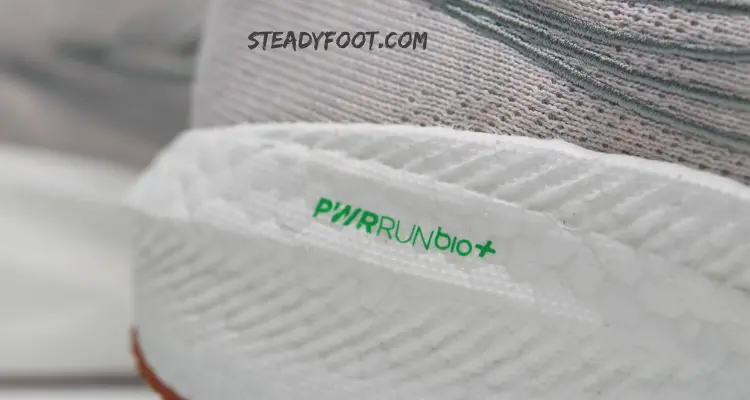
The new Triumph 21 RFG introduces PWRRUN Bio+, a midsole crafted from a remarkable 55% corn-based foam. This shift is noteworthy as it maintains the desired look and feel while reducing the reliance on plastics in the midsole.
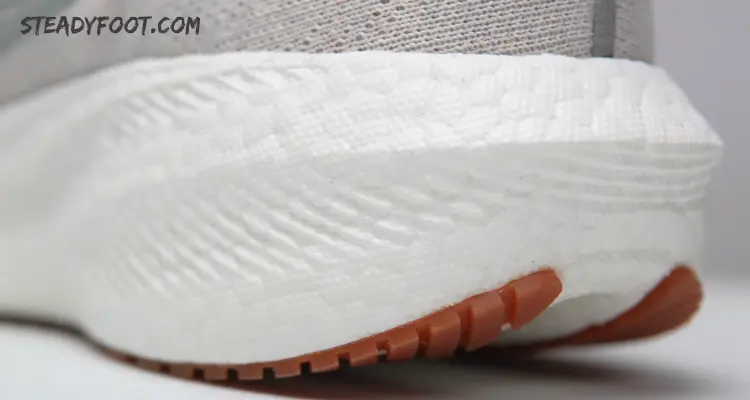
Additionally, the outsole incorporates 80% gum rubber. The outsole not only looks great but also aligns with a commitment to sustainability by minimizing the use of petrochemicals in its composition.
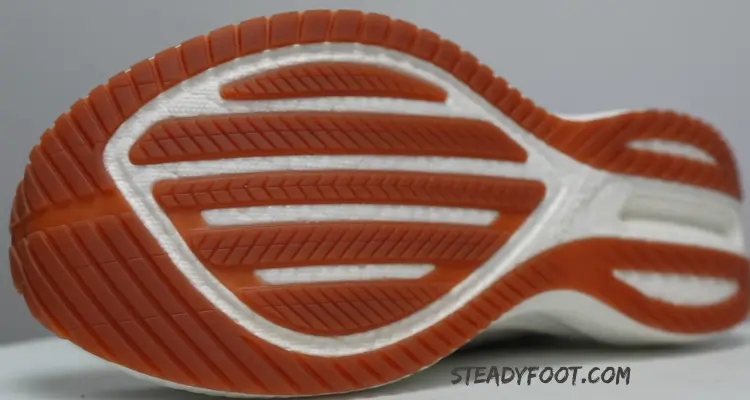
Moving to the upper, the Triumph 21 RFG has an upper made out of cotton which looks a lot like the Saucony Triumph 20. However, the upper takes an eco-friendly leap with the incorporation of plant-based dyes in the colorization process.
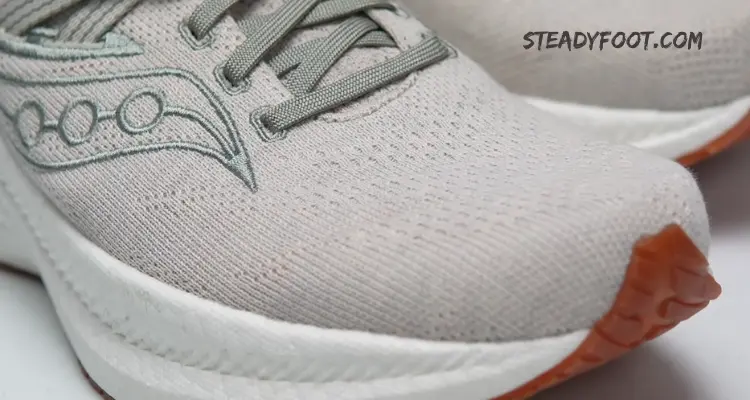
Related:
Triumph vs Triumph RFG
Similar to the regular Triumph 21 and Triumph 20, the Triumph RFG maintains the same 10mm drop and the stack height remains consistent, with 37mm in the heel and 27mm in the forefoot.
From my observation, the last of the upper appears unchanged, and the amount of padding distributed throughout the shoe seems consistent as well.

So it seems that Saucony has maintained key features in the Triumph RFG that have been appreciated in its regular siblings.
With the Triumph RFG, it seems that Saucony is trying to give us the exact same shoe in a more eco-friendly form, and I really appreciate this. It provides an opportunity to directly compare the eco-based midsole foam with the non-eco-friendly counterpart found in the regular Triumph series.
In terms of weight, the Triumph RFG is somewhat heavier than the non-eco versions, with the men’s version being 0.6 oz. heavier and the women’s version being 0.9 oz. heavier.
Overall, I feel like this is really great progress in terms of eco-friendlier foams that are out there.
Related:
What it feels like to run in the Triumph RFG
I absolutely love using the Triumph RFG as a daily trainer and you’re going to find that it has a decent amount of versatility too because as you’re compressing that foam, it gives you back a nice amount of pop. So, you’re going to be able to use this for your daily training and maybe even some of your faster-paced runs as well.
In my comparison with the regular Triumph, I think that the only time that I really noticed a big difference was on a longer run that I took the Triumph RFG on.
But by the time I got over about a dozen miles in the Triumph RFG, the slight extra firmness became more noticeable. However, on my everyday and shorter runs, the Triumph RFG felt like a fantastic shoe.
Again, the regular Triumph was a little bit softer, and especially in the forefoot, I felt like I was sinking into the foam in a pleasant way just a little bit more compared to the PWRRUN Bio+.
One last thing! Normally, the Triumph is a shoe I have been recommending for my larger, taller friends due to the dynamics of the way PWRRUN+ compresses and decompresses through the gait cycle.
With the introduction of PWRRUN Bio+, I would continue to recommend the Triumph RFG to my larger, taller friends, as it maintains those dynamics while incorporating a more eco-friendly foam.
Next, if you’re going to build a rotation around the Triumph 21 RFG, I feel like there’s a lot of really great options for you to do that…
Related:
Shoes you can pair with the Triumph RFG

For racing, you can stick with Saucony and get the Endorphin Elite. There seems to be a lot of shared DNA between these two shoes. Both exhibit similarities in the shaping of the forefoot and the intended mechanics of landing, rolling through, and pushing off in your foot strike, providing a familiar feel across both models.
While they sit on opposite ends of the spectrum in terms of weight, speed, and materials, the shared DNA might make for a seamless transition between them for your running needs.
For those workout days that bridge the gap between the Triumph 21 and the Endorphin Elite, I think you should consider the Brooks Hyperion Max.
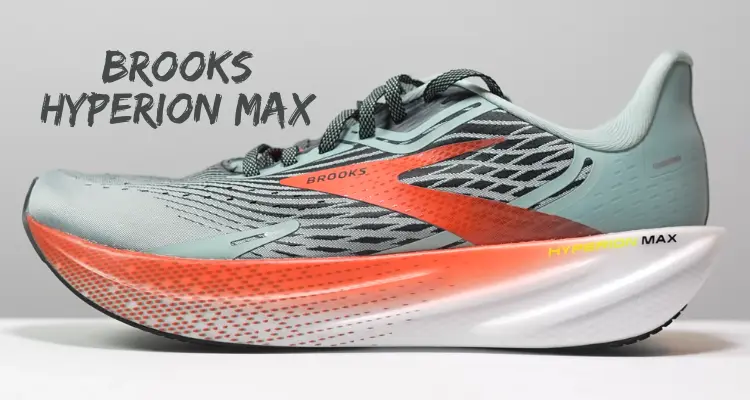
The Hyperion Max is a shoe that uses Brook’s DNA Flash midsole foam which is a Nitro-infused midsole foam that’s very fun to run in and make the Hyperion max a great shoe for fast up-tempo type of workouts.
While it might feel a bit dense at easy paces, this density becomes an asset as you pick up the pace. Combining the Triumph 21 RFG, the Endorphin Elite, and the Hyperion Max in your rotation could create an enjoyable and versatile lineup for your running routine.
Related:
Shoes that compete with the Triumph RFG
A strong contender in the same category as the Triumph is the New Balance 1080v13, which hit the market on October 13th, 2023.
The 1080v13 has got a lot of brand-new updates, and its use of Fresh Foam X, while not an eco-based foam, provides an enjoyable and responsive feel.
If you appreciate the characteristics of cushioned daily trainers but are looking for a shoe that can handle faster paces and offers a bit more nimbleness, the 1080v13 could be an excellent choice for you. Its combination of updates and performance features makes it a compelling competitor to the Triumph.
Another shoe worth considering alongside the Triumph 21 RFG is the Adidas Boston 12. Renowned as a fantastic daily trainer, the Boston 12’s design, with wider flanges in the back and the combination of Lightstrike and Lightstrike Pro in the forefoot, contributes to a comfortable daily training experience.
I feel like both the Triumph RFG and the Boston 12 appear to cater to individuals who prefer a slightly denser and firmer feel and provide stability during easy runs.
| Where to buy (not affiliate) | ||
|---|---|---|
| Saucony | Running Warehouse | |
Nike Structure 25 (Full Review)
We didn’t get a Structure update last year, but the Structure 25 is a completely redesigned shoe and it’s very different from the Structure 24.
After having thoroughly tested the Structure, I can conclude that the Structure 25 is currently the most supportive Nike trainer
Midsole

The midsole foam in the Structure 25 has been switched to Cushlon 3, but I don’t consider it an upgrade since this foam lacks significant energy return and doesn’t feel very bouncy.
As a result, the Structure doesn’t offer the same fun or engaging ride compared to other trainers equipped with more modern foams.
In my opinion, if Nike opted for a ZoomX midsole foam in the Structure series, it would undoubtedly create a much more exciting and engaging running experience.
Nonetheless, the Structure, in its current state, gets the job done and stands as a great choice for runners with high arches.
Outsole
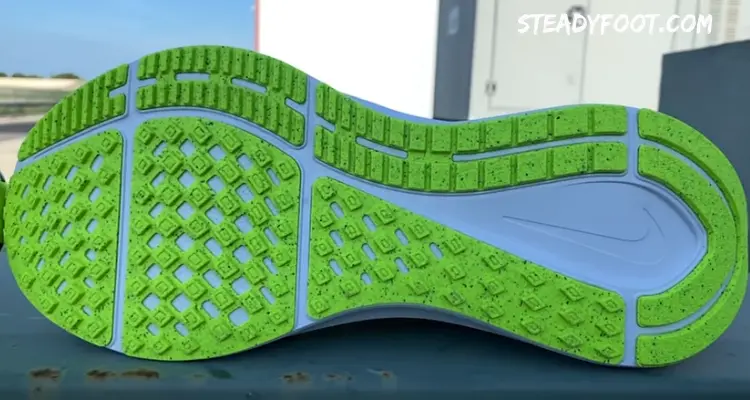
The main strength of the Structure lies in its outsole. The outsole has got plenty of thick and hard-wearing rubber which is super durable. Additionally, the outsole boasts protruding lugs, which provides excellent grip, even in rainy conditions.
Upper
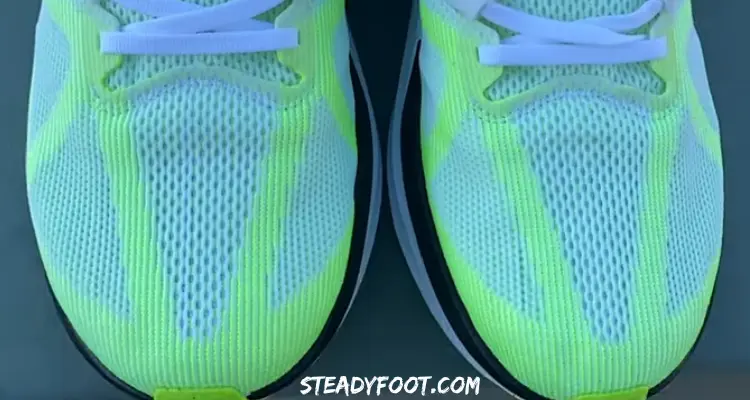
The Structure 25 comes with a traditional upper that offers comfort, but it tends to be warm. While there’s a bit less padding compared to the Structure 24, it’s a shoe better suited for cooler climates than warmer ones.
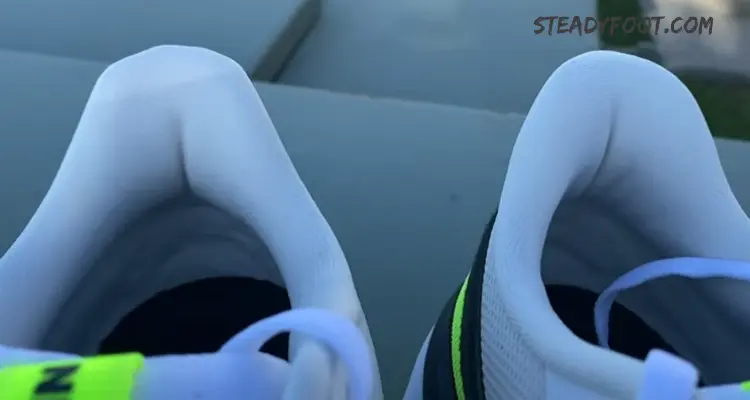
The tongue isn’t gusseted, so there’s a slight tendency for it to slide, but it’s not overly bothersome.
In terms of fit, the Structure 25 is true to size, but like most Nike running shoes, it leans towards the narrow side. It feels most comfortable when worn with thin socks.
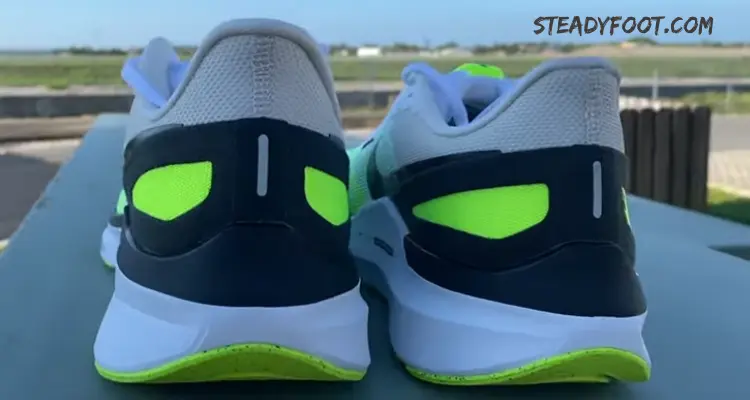
This version of the Structure, the 25, stands out as more supportive than its predecessors. It features an extra heel clip at the back, increased arch support, and a firmer ride, resulting in less lean bias.
| Where to buy (not affiliate) | ||
|---|---|---|
| Nike | Dicks Sporting Goods | |
Related:
Adidas Solar Glide 6 (Full Review)
The Solar Glide 6 is basically just an upper update and the midsole appears to be exactly the same.
Sustainability
A big part of Adidas running shoes is the recycled content in the upper. They have this program where they pull ocean plastic out and transform it into materials that can be used in the upper, and 50% of the upper is used from recycled content.
Related:
Midsole
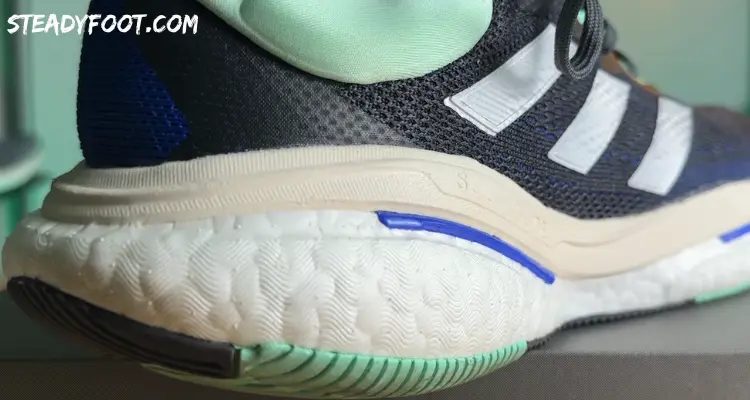
We still have that dual-density setup with the EVA foam on the top and the very recognizable Boost foam on the bottom with its double-bubble Boost implementation with the first bubble being in the heel and that second bubble being under the forefoot.

I think the midsole is more focused on shock absorption and cushioning rather than energy return. The Solar Glide 6 isn’t the most lively shoe out there because I think that top layer of EVA foam kind of dampens the Boost experience.
But if you’re heavy on your feet, I think this will work quite well for you mainly because it’s quite stable and you have quite a bit of foam to absorb all that impact.
The Solar Glide uses a technology called LEP which stands for Linear Energy Push.
The core idea behind LEP is it kind of stores energy and almost acts as a plate to help you with energy storage and energy release. So, LEP acts as a stabilizing force and as an energy storage force.
In my opinion, I think this works better as a more stabilizing force. It’s not the springiest plastic plate I’ve ever felt, but it does provide a very stable experience and I would definitely classify this as a very stable neutral shoe.
Outsole
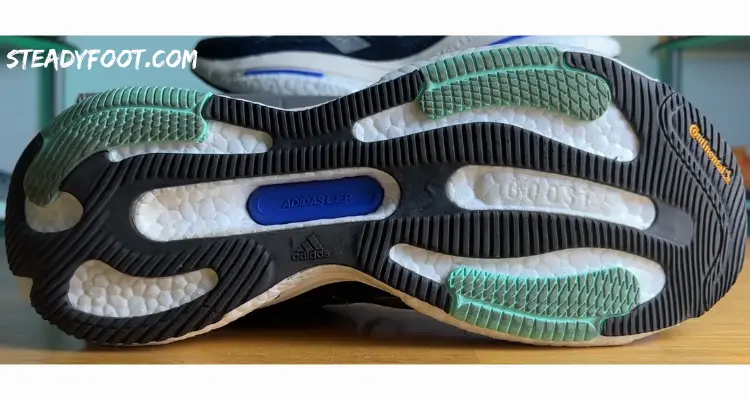
On the outsole, we have full-length Continental rubber coverage, which is probably why the Solar Glide 6 weighs so much, but it’s also part of the reason why the shoe will last you quite a while.
So, if you’re looking for a durable workhorse daily trainer, you’ll be happy to see the rubber coverage has not changed.
Stability
The Solar Glide 6 is not a stability shoe, but it’s a very stable neutral shoe.
In terms of the platform, the Solar Glide 6 has a really wide forefoot and a really wide heel section, which gives you a ton of ground contact, a very stable base to land on, and a very smooth consistent stable ride.
In my experience, this is a large platform to run on mainly because the outsole is so wide and the midsole has quite a bit of heft to it.
Upper

The upper is still that circular knit kind of fabric. Breathability is pretty comparable.
However, at the top of the shoe, they did change the toe bumper. It’s a little bit more substantial in the Solar Glide 5, giving you a little bit more while the Solar Glide 6 has a slightly more flimsy toe guard, giving you a slightly more closed-off experience. It’s nothing major; it’s just one of those small tweaks between the two versions.
However, something that was a big change was the tongue. The tongue on the 5 was this really thin piece of material that just did not perform well.
The top of the tongue was also super bulky and plush providing a very disjointed experience. Moving to the Solar Glide 6, Adidas did fix the problem although the tongue is still super bulky and tall at the top.
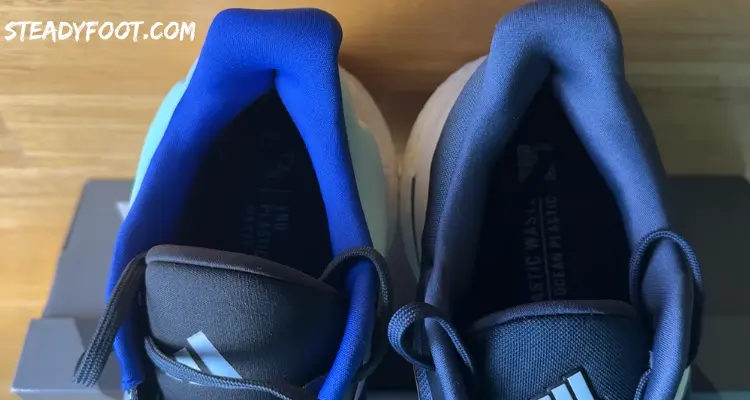
However, the midfoot section of the tongue is now a little bit more padded, it’s not flimsy, and does not move around a whole lot compared to last year.
The tongue is still non-gusseted, but it does provide a much better experience over last year.
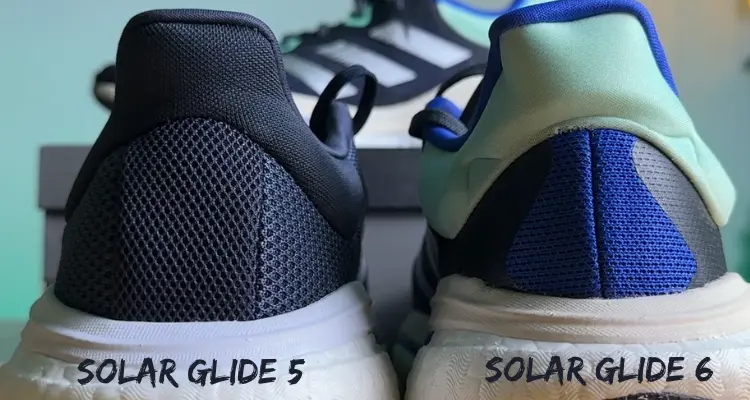
The last change between the Solar Glide 6 and 5 is the heel counter. On the Solar Glide 6, they added some foam along the ankle and Achilles section, and I think this is more aesthetic; it doesn’t only do too much mainly because the padding feels the same on the inside.
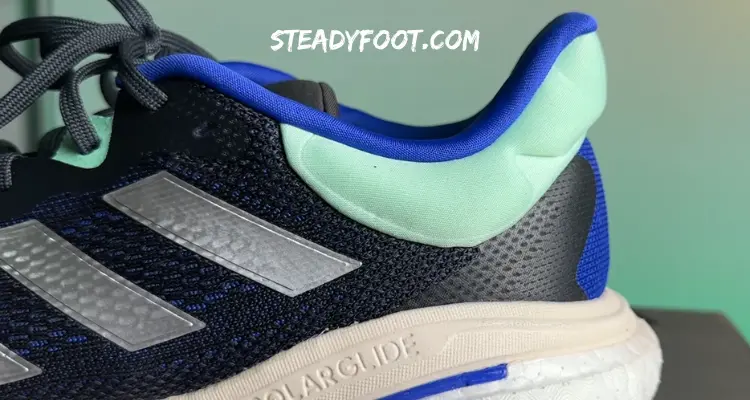
However, the heel counter has been updated in a subtle way. Basically, on the Solar Glide 5, the area where your Achilles sits was just fabric. There was no real plastic and then on the lateral and medial side, you had these two kind of plastic plates.
On the Solar Glide 6, they updated it to a more traditional very consistent heel counter where it’s basically one piece of plastic around the back part of your heel so it’s a little bit more firm and there’s no fabric basically directly where your heel and Achilles.
The Solar Glide 6 has a slightly better lockdown although I wasn’t completely happy with in terms of heel slipping. You really have to get the laces quite tight to make sure your foot stays secure.
But otherwise, it is an improvement compared to last year where basically there was nothing but fabric in the middle of where your heel sits.
Weight
The Solar Glide comes in at 11.4 oz. which is about 4/10 of an ounce decrease compared to last year so we do lose a little bit of weight, but 11.4 oz. definitely puts this shoe on the heavier side of things.
| Where to buy (not affiliate) | ||
|---|---|---|
| Adidas | Foot Locker | |
Nike Pegasus 40 (Full Review)
Nike typically doesn’t provide extensive information on the specs of their shoes, but I’ll share what I’ve gathered.
Midsole / Outsole

Nike Pegasus has an all-React midsole with a relatively tall stack height. Typically, the Pegasus series maintains a 10mm drop. Alongside the React midsole foam, there are two Zoom Air pockets, one in the forefoot and one in the rear.
While I do recognize that the midsole feels different and softer, I’m not sure that I necessarily like the feel the Zoom Air pockets.
In the previous Pegasus iterations, these pockets used to be quite prominent, especially in a new pair of Nike Pegasus. However, I haven’t felt them as distinctly since maybe the Pegasus 37. It seems like Nike has tuned the Zoom Air pocket to be less noticeable and prominent in recent iterations.
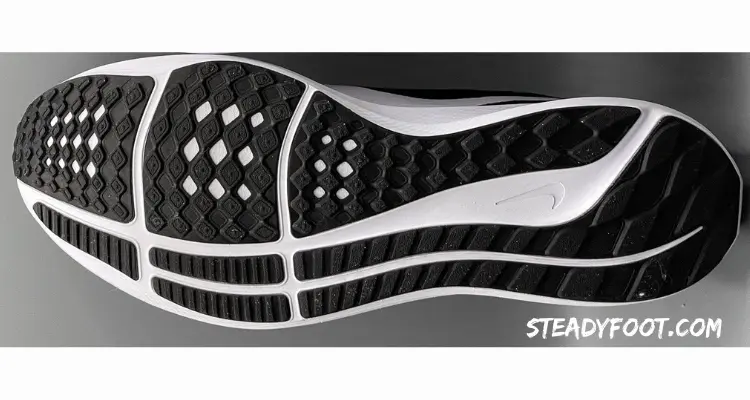
On the bottom, the reliable waffle pattern outsole, which I’m a big fan of, provides traction and durability.
Upper

Moving on to the upper, Nike has introduced a new material, and personally, I find it to be much more comfortable, roomier, and more breathable than anything I’ve seen in a Pegasus before.
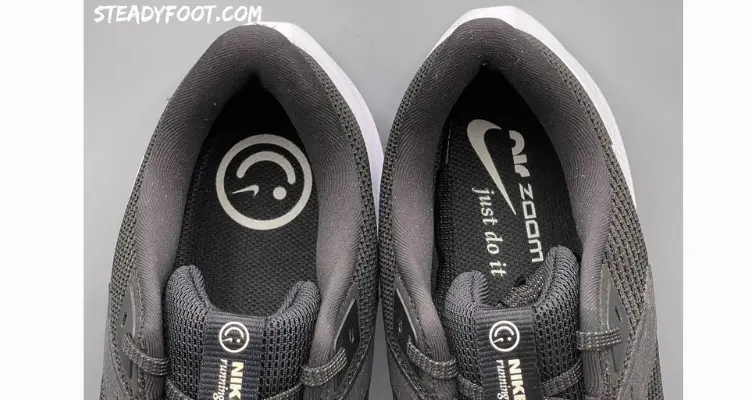
As a fan of knit materials, I appreciate that this upper strikes a good balance between the stretchy comfort associated with knits and the added structure needed for those who prefer a more snug fit in their daily training shoes. It seems to offer the best of both worlds.
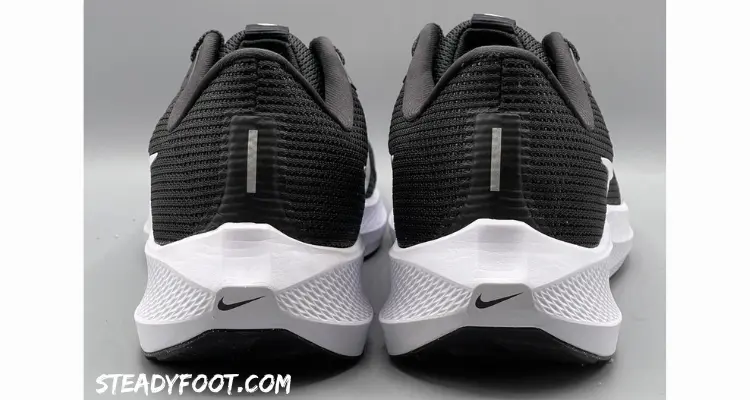
The heel flare on the back of the Pegasus continues to be reduced, almost to the point where it feels like there’s no heel flare at all. The amount of padding is in the moderate-to-light range, which aligns well with my preference for a daily trainer.
Let’s talk about what it was like to actually running the Pegasus 40…
What it feels like to run in the Pegasus 40
In my experience, the Pegasus 40 is probably one of the best iterations of the Pegasus in recent years. I personally feel that the Pegasus series hit its peak at version 36, and the current version seems to be softer and more runnable compared to the last couple of iterations.
I will say though that I do think that React foam has been softer in other shoes before and I think that it could still be a little bit softer in the Pegasus 40, but it’s a lot better than the Pegasus 38 and a lot better than the Pegasus 39.
I took the Pegasus 40 out for what I believe are its intended use cases—some easy runs, including a 2-hour run for longer-run testing, and some easy runs with strides to assess the shoe’s performance at shorter distances and various paces.
The only downside I found was that I didn’t want to spend a really long time in it. It performed well for the first 45 minutes to an hour, but after about 1 hour and 15 minutes, I started to develop a hot spot in my right foot.
Overall, if I were to continue logging more miles in the Pegasus 40, I’d likely reserve it for days when I plan to probably run for about an hour or less.
I think for a lot of people that are picking up the Pegasus that are either new to running or returning to running after a really long break, I don’t think that’s going to be a problem for you guys.
Shoes you can pair with the Pegasus 40
If you do love the Pegasus 40 and are looking for other shoes to complement your running lineup, consider these options…
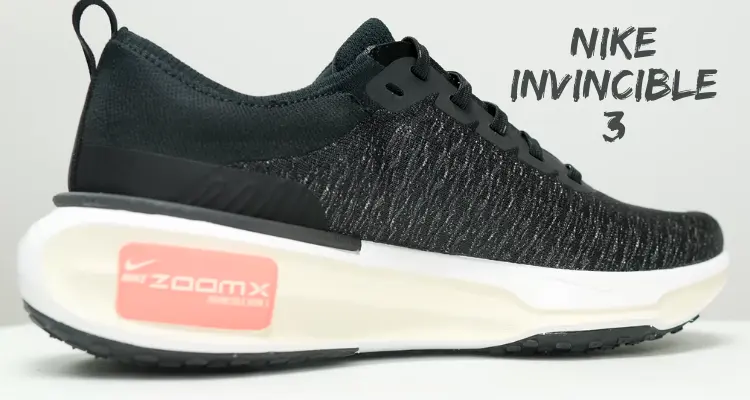
For your longer days, the Nike Invincible Run 3 could be a great choice. When it comes to race day, you might want to opt for the Vaporfly 3. Both of these options should provide solid performance and enhance your overall running experience.
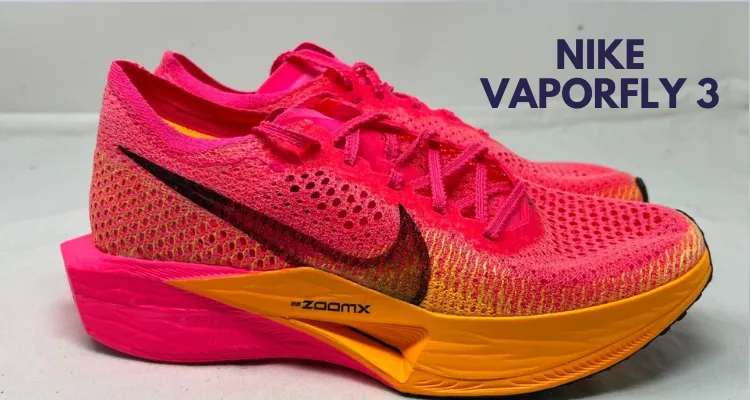
Related:
Shoes that compete with the Pegasus 40
The shoe that really catches my attention as a competitor to the Nike Pegasus 40 is the Adidas Adizero SL which is a shoe I’ve been pleasantly surprised by.
The SL features Lightstrike as the EVA base foam, serving as the main carrier, and includes a puck of Lightstrike Pro, Adidas’s racing foam, in the forefoot.
Another recommendation for comparison, if you’re considering the Pegasus 40, would be the Reebok Float Ride Energy 5.
While The Float Ride shares similarities with the 4 and 3 that preceded it, the 5 is a significant upgrade, particularly with the changes made to the midsole.
| Where to buy (not affiliate) | ||
|---|---|---|
| Nike | Fleet Feet | |
Asics Gel Cumulus 25 (Full Review)
The Cumulus 25 undergoes a total makeover from head to toe. While its appearance is notably distinct from previous Cumulus models, I’d say it carries a familiar feel reminiscent of the Cumulus 24.
In this complete redesign, the Cumulus 25 offers an additional two millimeters of stack height compared to the 24, all while maintaining the same 8mm drop.
Even though we have a larger midsole with more stack height, we actually lose a substantial amount of weight, which I am pleasantly surprised by. The Cumulus 25 weighs in at 9.4 oz., a considerable drop from last year’s 10.1 oz. and nearly a full ounce less than the Nimbus 25’s 10.3 oz.
Midsole
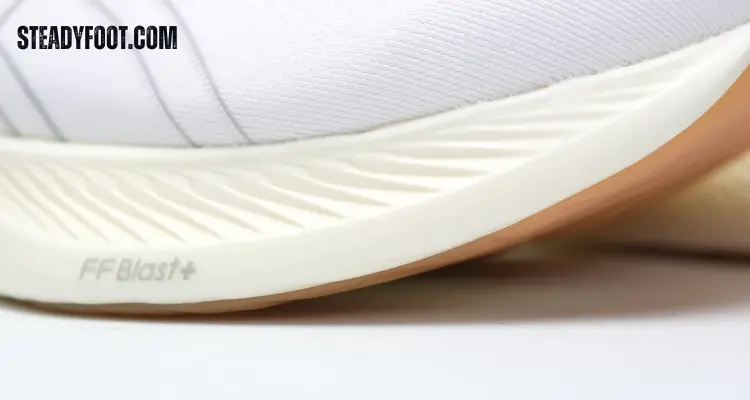
Asics now is using two cushioning technologies on the Cumulus 25 instead of three on the 24. The shoe now uses FFBlast+, which Asics claims is 15% lighter and softer, and 12% bouncier.
Similar to the Nimbus 25, the Cumulus 25 features Pure Gel in the heel to help absorb shock and enhance impact protection.

While the tangible impact of Pure Gel might be challenging to feel under your foot, it does seem to make a difference, especially when measured using some sort of tech.
So, Asics successfully delivers a softer, bouncier midsole compound that becomes evident once you slide your foot into the shoe.
Outsole
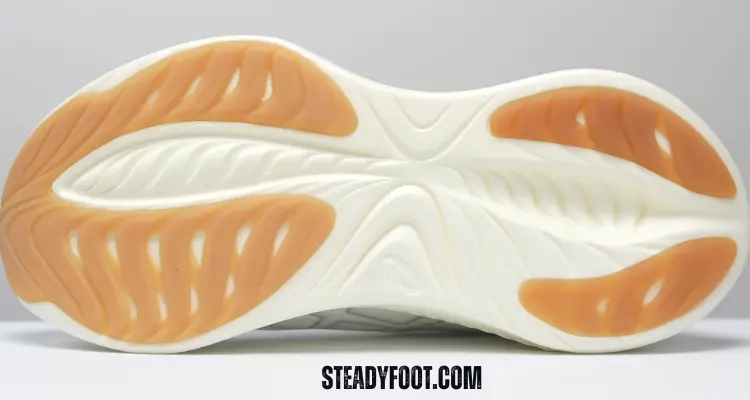
The Cumulus 25’s outsole, while relatively smooth, provides a reliable grip on conventional surfaces like asphalt and concrete.
Comparatively, the Cumulus 24 featured more rubber on its outsole. The deeper grooves between rubber sections in the 24 contributed to a better and more versatile grip that allowed for stability on various surfaces compared to the smoother texture of the Cumulus 25.
If you’re just going to be using the 25 for true road running, the Cumulus 25 should perform quite well. However, if you intend to venture onto different terrains, the 24 might offer a more versatile traction pattern.
The other thing about the Cumulus 25 is it has a larger surface area on the outsole to try to help enhance stability. While it may not be the epitome of stability in neutral shoes, it does provide a moderate amount of support.
Upper
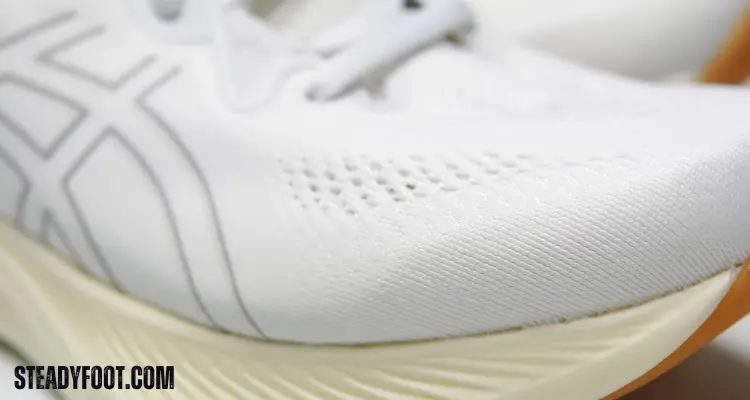
The engineered Jacquard mesh continues to provide exceptional comfort and containment for your foot. If you’ve tried an Asics shoe before, this will likely be a familiar and comfortable fit.
However, one aspect I’m not entirely fond of is that the engineered Jacquard mesh isn’t the most breathable. While it’s acceptable, it might not be the best, especially as temperatures rise in warmer months.
In terms of fit, the Cumulus 25 seems to offer a bit more room compared to the Cumulus 24, especially through the midfoot and forefoot. This could make it more accommodating for individuals with wider feet.
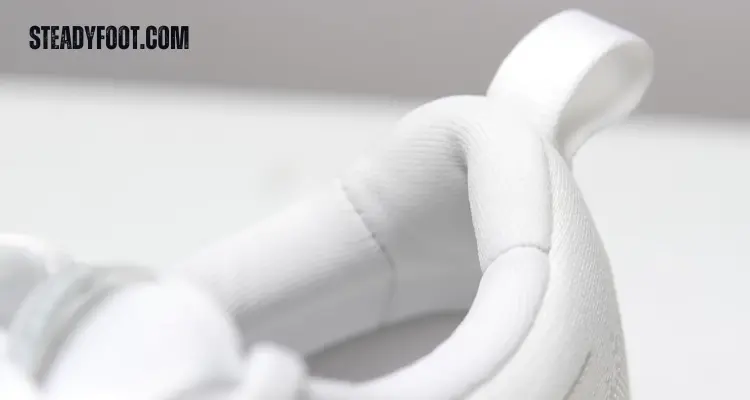
Moving to the back of the shoe, the ankle and Achilles area now features more plush feel, providing a comfortable feel. Asics appears to have trimmed down some padding on the 25 to reduce weight, which results in an almost one-ounce weight reduction.
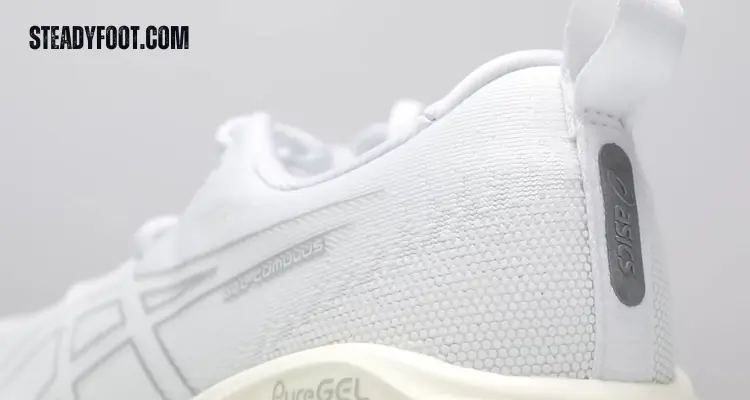
Overall, the lockdown is excellent, and the shoe feels comfortable. So, if you’re someone who likes some more moderate level of cushioning around the ankle, you’ll be happy with the 25 because I’d rather have that weight trade-off than just a tiny bit more cushioning.
Asics Cumulus vs. Nimbus vs. Novablast
In my opinion, the line between the Cumulus and Nimbus series seems to be blurring, especially with regard to the midsole.
The FFBlast+ in the Cumulus feels distinct from the FFBlast+ in the Nimbus 25 and the Novablast. It’s a bit more dense, but it doesn’t make the shoe feel hard by any means.

For those who found the Novablast or the Nimbus too mushy, squishy, or unstable, I believe the Cumulus 25, with its stability features incorporated through its geometry and the slightly denser formulation of FFBlast+, might be a better fit for you.
Interestingly, even though the Nimbus has more stack height, the Cumulus 25 features a wider outsole pattern. I was expecting the larger shoe to have a larger platform, but that’s not the case here.
What it feels like to run in the Cumulus 25
I’ll emphasize that, despite its bulkier build, the Cumulus 25 performs well across a range of paces. It might take a bit of time to get used to the extra bulk, especially if you’re transitioning from the Cumulus 24.
I’ve taken the Cumulus 25 for lots of easy runs and I felt like it was a really perfect shoe for that. I did take it also for some strides to see if this shoe could pick up the pace and I do feel like because it is a little bit on the firmer side, it responds well when I’m pushing into the ground a little bit harder.
If you’re focusing on my typical routine of easy runs and daily training, the Cumulus 25 is undoubtedly a reliable workhorse. However, due to its wider footprint, I wouldn’t consider it the go-to shoe for an entire workout session.
In summary, the Cumulus 25 is well-suited for individuals seeking a versatile daily trainer with the durability to handle various runs. It’s a shoe that can seamlessly transition from your regular training to casual wear, making it a reliable choice for consistent use.
Shoes you can pair with the Cumulus 25
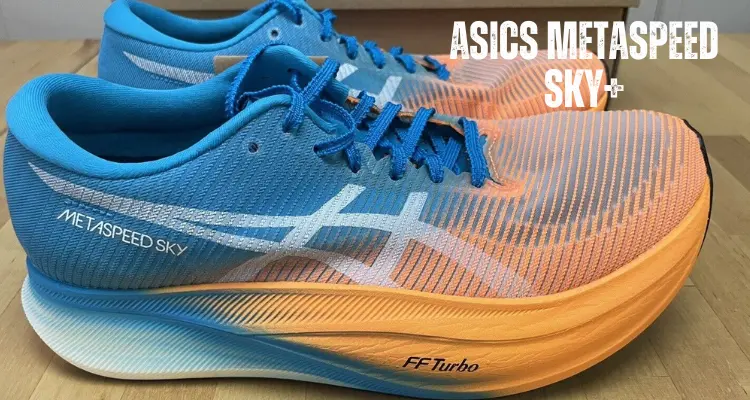
When it comes to finding a racing partner for the Cumulus 25, the Metaspeed Sky+ seems like the ideal choice. This pairing can cover everything from everyday training and workouts to actual race days.
If you want to go to the recovery side and something that’s a little bit more comfy than the Cumulus, I really recommend the Nimbus.
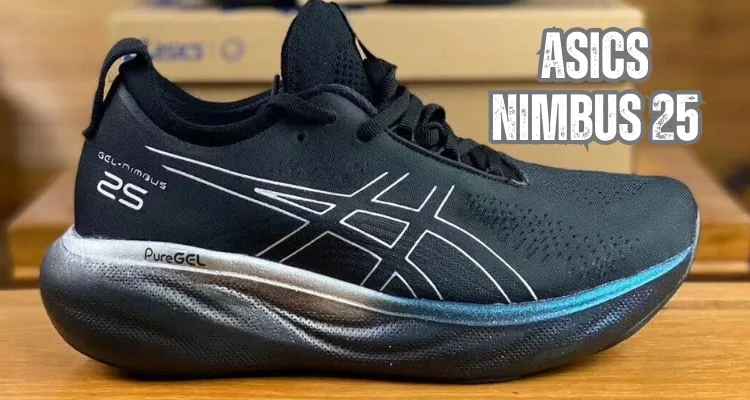
The Nimbus provides the cushioning and relaxed feel needed for those easy, slow-paced, and long recovery runs. This combination of Cumulus for regular training and Metaspeed Sky+ for racing, along with Nimbus for recovery, creates a well-rounded set for different running needs.
Shoes that compete with the Cumulus 25
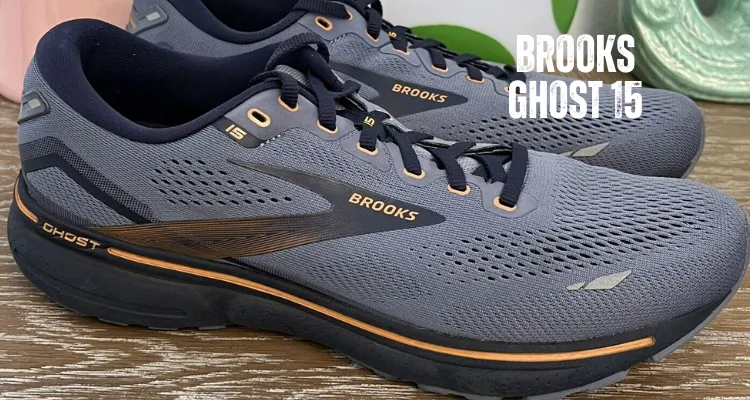
If you’re considering alternatives, I’d say the Cumulus 25 appears to be directly targeting the Brooks Ghost. While both the Cumulus and Ghost share some similarities, I still would prefer the Asics Cumulus 25 any day over any of the Brooks Ghost models.
Related:
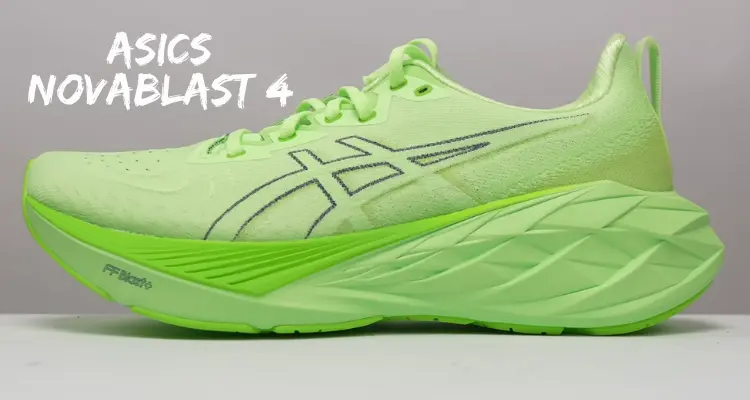
Another option to look at is the Novablast 4. The Novablast’s combination of squishiness and responsiveness makes it versatile for various activities, and it even doubles as a casual wear option.
However, if you find the Novablast too soft or unstable, the Cumulus 25 provides a more stable and slightly firmer alternative.
| Where to buy (not affiliate) | ||
|---|---|---|
| Asics | Running Warehouse | |
ON Cloudstratus 3 (Full Review)
Midsole
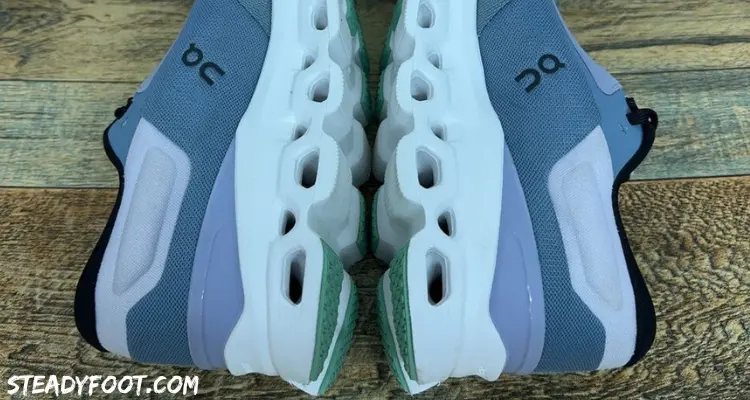
The Cloudstratus features more than just a solid block of Helion foam in its midsole. Alongside the Helion foam, the shoe uses a Speedboard on the bottom. This Speedboard is constructed from stiff polypropylene material and contributes to stability in the midsole design. The combination of Helion foam and the Speedboard offers both cushioning and support during running.
Outsole
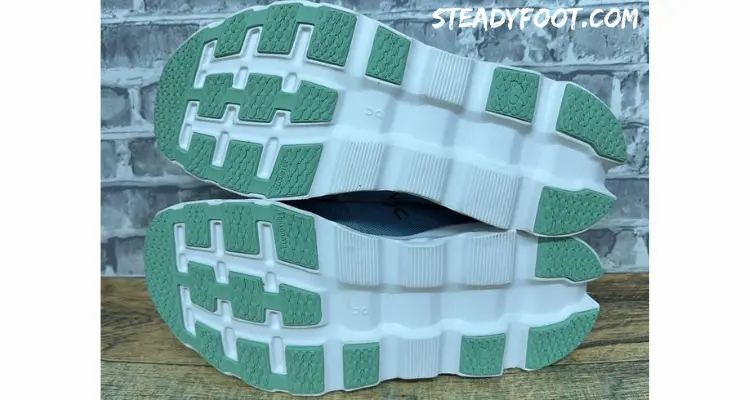
Moving to the outsole, we’ve got some rubber coverage on it and sometimes, you’re running directly on the midsole foam. So, they’re keeping the rubber nice and light and even where there is rubber, there’s not a ton of it and it’s not very thick.
I think a big distinguishing feature about this outsole is that you’ve got a huge channel running down the middle of the shoe.
Upper
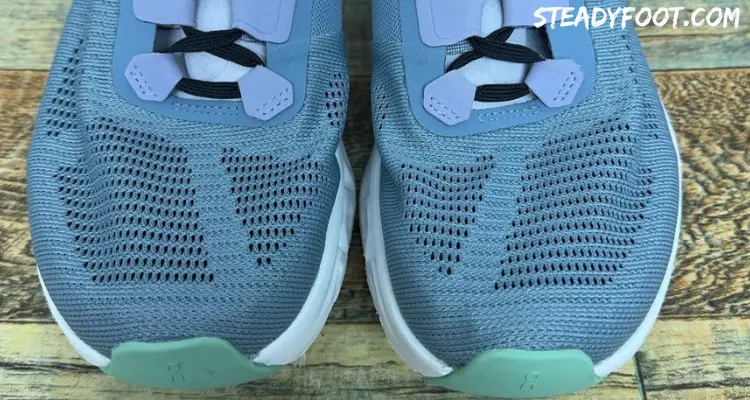
The ON Cloudstratus has renowned Swiss engineering and an immaculate sense of design. The upper, crafted from 75% recycled polyester, not only is sturdy but also provides impressive stretchiness and ensures a comfortable fit on your foot.

The tongue has just enough padding without going overboard, which provides a comfortable feel. Additional padding is strategically placed around areas that come in contact with your ankle and heel, giving you a firm and supportive heel cup.
Weighing in at 10.3 ounces for men’s size 9, the ON Cloudstratus falls on the heavier side for a daily trainer, but considering its max cushion design, the weight seems pretty acceptable.
Fit
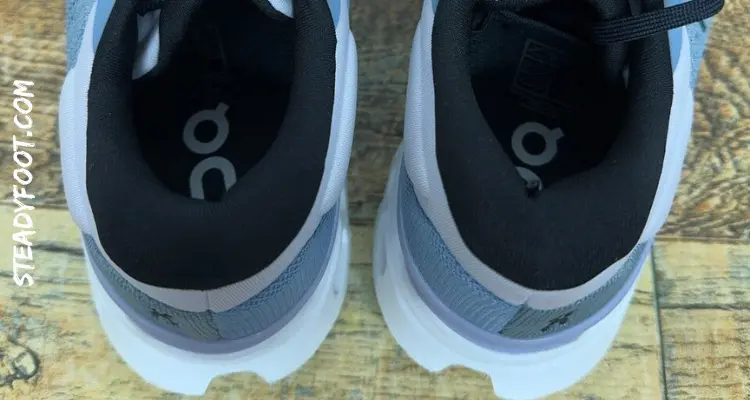
When I think of Swiss engineering or things that are more of like a European fit and finish, I think of things as being very snug and not having a lot of room.
Yet, in the Cloudstratus, I feel like the upper provides plenty of room so much so that I was able to run with waterproof socks, which are generally thicker than regular running socks, and I still felt good in the shoe because waterproof socks tend to be a lot thicker than even the thickest regular running socks.
I’m still able to get a good fit to make it comfortable for a longer amount of time that you may be in the shoe.
What it feels like to run in the ON Cloudstratus
In my first run with the Cloudstratus, I was a bit puzzled, but as I’ve continued running in it over the past few months, I think I’ve found its sweet spot.
Even though the Cloudstratus looks like a max cushion shoe, I don’t like it as a true max cushion shoe and I don’t like it for my recovery runs. The Helion foam and cloud tech design, while innovative, feel a bit too firm for what I look for in a max cushion shoe.
For me, the Cloudstratus is ideal when I’m heading out for a medium or long run that’s just going to be at a very easy aerobic pace. This is where I find the Cloudstratus excels for me.
I feel like the Cloudstratus rolls really well. How? The overall geometry of the shoe does have a little bit of a curl up at the toes to help it roll through that foot strike and gait cycle. Plus, it also has this channel that’s going through the center of the outsole along with the Speedboard that’s underneath.
Again, I appreciate the Cloudstratus most during my medium-length and long runs, especially when I’m moving at my usual pace or slightly faster than my recovery days. This is when I feel a better synergy with the Cloudstratus and so it makes for a much better running experience for me.
| Where to buy (not affiliate) | ||
|---|---|---|
| ON | Running Warehouse | |
New Balance 1080v13 (Full Review)
Midsole

The midsoles are like the soul of your running shoe. The 1080v13 has a Fresh Foam X midsole which is kind of like the classic EVA foam like Saucony’s PWRRUN and Brooks DNA Loft, but here’s the cool part – this Fresh Foam X is on the softer side, unlike the slightly firm identity of other EVA foams.
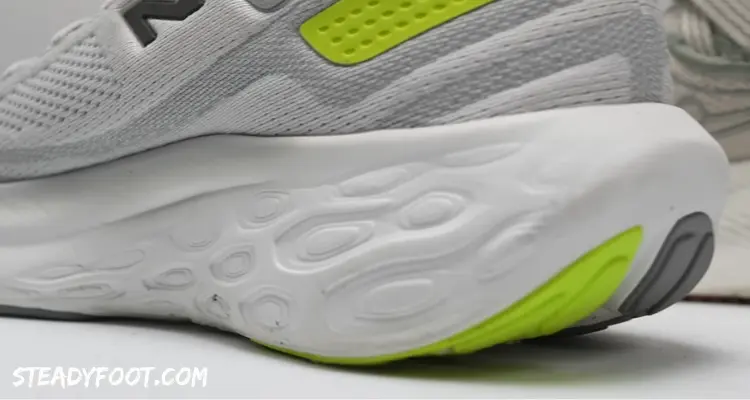
So, when you hit the pavement, the midsole is going to do a great job at absorbing a lot of the impact you’re going to get from that pounding on the pavement.
So, the 1080v13 keeps it simple with a less pronounced rocker compared to some other max cushion options. There’s a subtle rocker in the forefoot for a bit of roll, but it’s not as pronounced as in shoes like the Saucony Triumph or the Endorphin Shift.
If we’re looking at the realm of max cushion shoes, the 1080v13 is going to be one of the most traditional midsole setups out there.
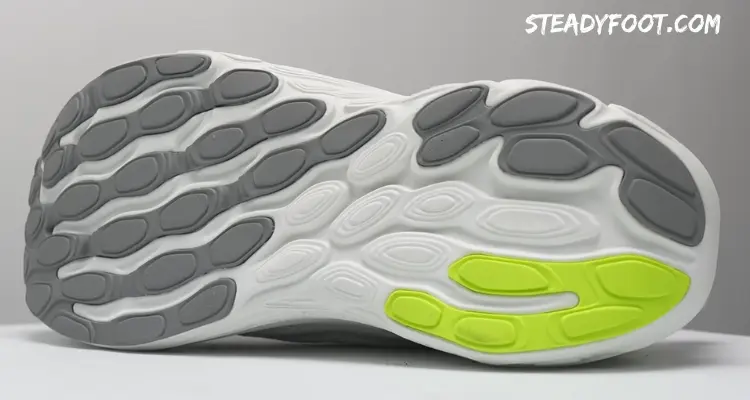
Upper
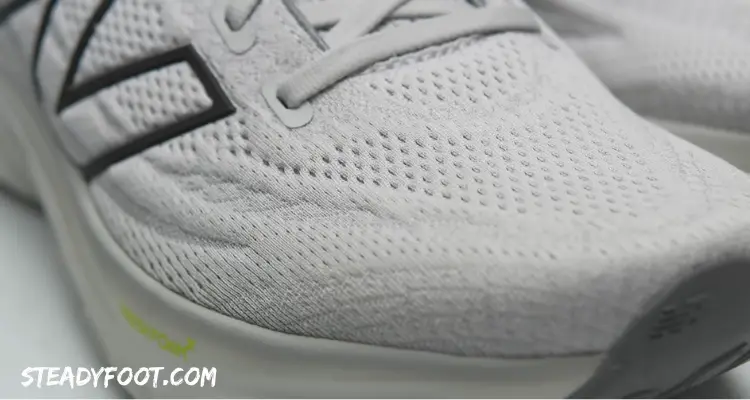
The upper of the 1080v13 uses a super soft and comfortable knit material. It’s not only nice to the touch but also well-designed. The heel collar is generously padded and ensures a comfortable fit.
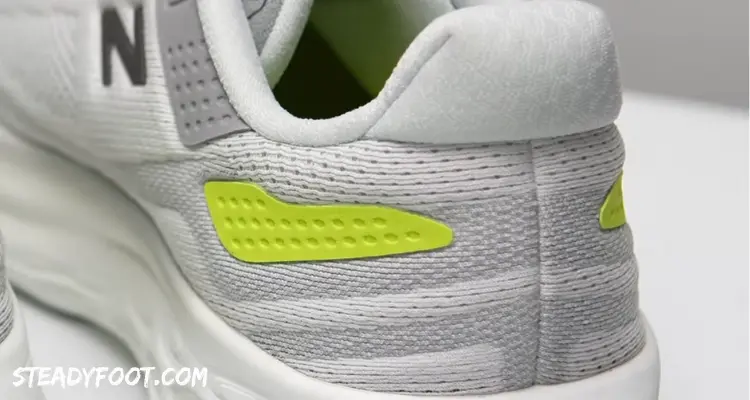
Additionally, the heel counter features a plastic stabilizing piece to try to prevent any unwanted wiggling. I found the overall lockdown and fit are spot-on and the shoe provides a secure feel during runs.

The upper is not as warm as the Nimbus although it is a knit material that is perfect for running in all seasons. Unlike the Nimbus, the 1080 isn’t overly warm.
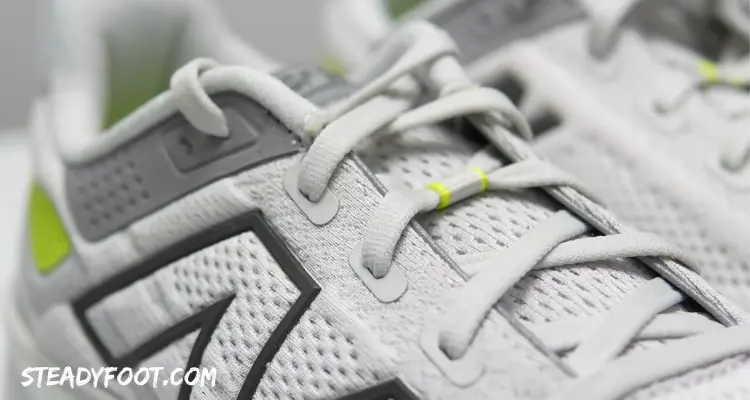
The super soft laces allow for a secure yet comfortable fit. You can pull them down as tight as you need to and they’re not going to dig into the top of your foot and cause any discomfort up there.
The midfoot provides a generous feel, which contributes to an overall perfect fit that extends from heel lockdown through the midfoot up to the toe.
So, if you’re looking for a daily trainer and prefer a shoe that’s not overly soft, the Shift 3 is the go-to choice. Its firmness and stability make it well-suited for those looking for a reliable companion on their daily runs.
| Where to buy (not affiliate) | ||
|---|---|---|
| Saucony | Running Warehouse | |
Saucony Endorphin Shift 3 (Full Review)
In the realm of max cushion daily trainers, the Endorphin Shift 3 doesn’t aim to be a lightweight speedster, but it does come in lighter than the Endorphin Shift 2.
Midsole
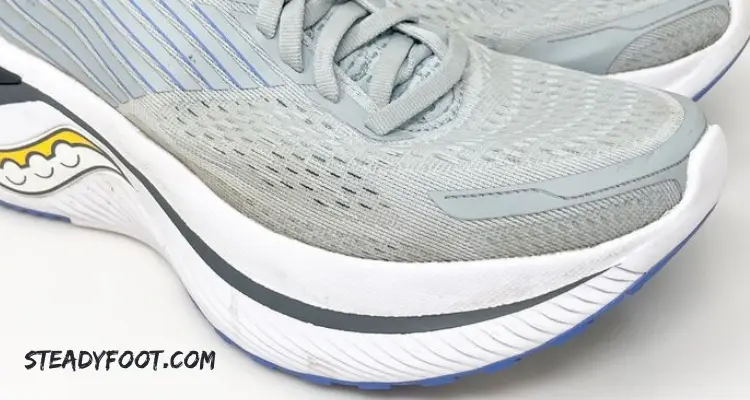
The star of the show is always the midsole. The midsole uses PWRRUN foam – a blend of EVA and TPU. It might not be PWRRUN PB, but it’s still a relatively light, resilient material that promises durability, ensuring your shoes can handle a substantial amount of miles. This midsole is the secret sauce for the enjoyable ride on many of my runs.
We’re diving into some serious specs here with a substantial 39mm in the heel and 35mm in the forefoot for that a 4mm drop – that’s a notable stack height, especially in the forefoot.
And if you’re all about that plush comfort, Saucony goes the extra mile by throwing in a PWRRUN+ sockliner to add an extra seven millimeters of padding to your shoe.
Upper

On the upper, we’re greeted with a lightweight and highly breathable mesh. It’s a tad thicker compared to other models in the Endorphin lineup, which aligns with the shoe’s focus on comfort over speed. The upper’s thickness is akin to that of the Saucony Tempus, albeit with a slightly different style.
Saucony seems to have nailed it again with the gusseted tongue – it’s thin, wraps around the foot nicely, and contributes to an overall comfortable and secure feel.
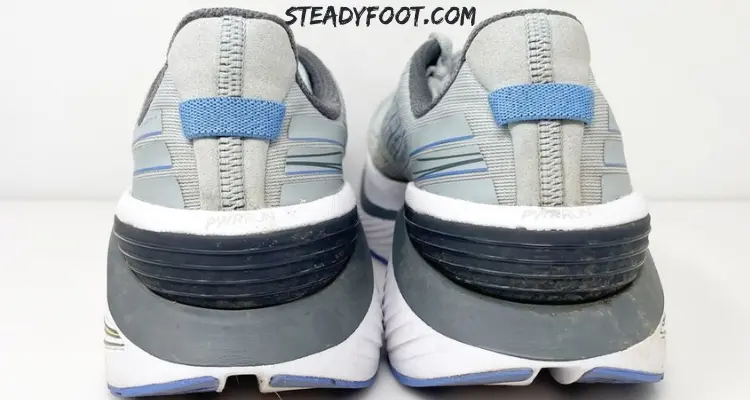
Saucony’s approach to the heel collar is one of the things I appreciate. They strike the right balance by not going overboard with padding, yet ensuring there’s ample cushioning to get the job done. The heel counter is very rigid, and they’ve thrown in a substantial heel clip at the back to create that very stiff heel counter.
When my foot settles into the Shift 3, the heel feels secure and snug without any unnecessary movement. The design ensures a comfortable fit while maintaining stability, which is a win-win for a daily trainer.
I found it quite difficult to get a grip on the pull tab because of the tight elastic. For those who like using pull tabs, be prepared to do a bit of finger gymnastics to get a good hold and assist in pulling your heel up.
Fit
In the fit department, the Endorphin Shift 3 runs true to size for me and provides a secure lockdown in the heel and across the midfoot.
What pleasantly surprised me was the generous room in the toe box – there’s ample space for my toes to spread out comfortably. This combination of a secure fit in critical areas and toe box roominess contributes to an overall comfortable and accommodating fit for my runs.
Outsole

On the outsole, Saucony has made a few tweaks while maintaining their signature style. The noticeable cutout running down the heel serves a dual purpose – not only does it save weight, but it also provides a touch of stability and direction.
The medial side features smooth rubber, while the lateral side boasts deeper grooves. The trusty Saucony XT900 rubber makes its appearance and proves as grippy as ever.
We also have a lot of exposed foam in the middle. Surprisingly, the level of the XT900 rubber coming around the outside and through the middle is nearly on par with the exposed midsole, which creates an interesting balance in the outsole design.
| Where to buy (not affiliate) | ||
|---|---|---|
| New Balance | Dicsk Sporting Goods | |
Best Running Shoes for High Arches – FAQs
What shoe brand is best for high arches?
New Balance, Asics, Hoka, and Adidas are some of the go-to brands for individuals with high arches seeking optimal comfort and support in their shoes. New Balance’s commitment to innovative technologies, Asics’ emphasis on stability and cushioning, Hoka’s renowned plush midsoles, and Adidas’ combination of style and functionality make them reliable choices for high-arched runners.
What shoe drop is best for high arches?
For individuals with high arches, minimal shoe drop is often recommended. Shoes with a lower drop, typically ranging from 4mm to 8mm, encourage a more natural foot strike and help distribute pressure evenly across the foot.
Are high arches good for running?
Runners with high arches often face challenges as their feet tend to underpronate, limiting the absorption of ground forces and potentially increasing the risk of injuries. Simply relying on shoes may not be sufficient to prevent or address issues related to high arches. It’s advisable for runners with high arches to focus on improving foot flexibility through targeted exercises and stretches. This proactive approach, combined with choosing suitable footwear, can contribute to a more comfortable and injury-resistant running experience.
Are Hoka shoes good for high-arched feet?
Absolutely! Hoka shoes, known for their plush cushioning and innovative designs, can be an excellent choice for individuals with high arches. The Hoka Clifton 9, in particular, is often praised for its superior comfort and ample support. The shoe’s well-crafted midsole provides excellent cushioning and promotes a smooth and comfortable ride while catering to the specific needs of high-arched feet.
Are neutral or stability shoes better for high arches?
For high arches, neutral shoes are generally recommended over stability shoes. High arches tend to result in less pronation, and stability shoes, designed to control excessive pronation, may not align well with this foot type. Neutral shoes offer the necessary cushioning without additional arch support, allowing the foot to move more naturally.
How should you run with high arches?
When running with high arches, it’s essential to focus on proper footwear and form to optimize comfort and reduce the risk of injury. Choose running shoes with adequate cushioning and arch support designed for high arches. Additionally, pay attention to your running form – aim for a midfoot or forefoot strike to enhance shock absorption. Strengthening exercises for the feet and calves can also improve overall foot stability. Listen to your body, and if you experience discomfort, consider consulting with a professional, such as a podiatrist or physical therapist, to ensure you’re addressing the unique needs of high-arched feet in your running routine.
In conclusion, finding the best running shoes for high arches is important for a comfortable and supported running experience.
Each runner’s needs are unique, but considering factors like arch support, cushioning, and stability can guide you towards the perfect pair.
Thanks for taking the time to explore this guide. I hope it has been helpful in navigating the world of running shoes for high arches. Your thoughts and experiences matter, so feel free to drop your comments below.
Happy running 🙂

I’m a huge fan of Hoka running shoes. For those with back issues, they’re super comfortable. Thanks for the helpful breakdown.